HAMBURGER HAPPINESS



A CELEBRATION OF BOOKS





ON THE HUNT FOR GATORS
KEEPING COOL IN THE KITCHEN





A CELEBRATION OF BOOKS





ON THE HUNT FOR GATORS
KEEPING COOL IN THE KITCHEN


The National Rural Electric Cooperative Association (NRECA) is asking the Environmental Protection Agency to consider reliability of the electric grid as well as the significant investment by electric cooperatives in control technologies before setting new limits on mercury emissions and filterable particulate matter from coal-fired power plants.

“Co-ops would have to invest millions of dollars more in retrofits to comply with this proposal or retire units prematurely, leaving the nation short on available baseload generating resources when energy demand is escalating,” said Rae Cronmiller, NRECA environmental counsel.
“With electric reliability at stake, we encourage EPA to withdraw this proposed rule and reconsider its impact to the electric grid.”
EPA proposed the new Mercury and Air Toxics Standards for power plants on April 23 and is expected to issue a final rule in 2024.

“To date, fPM emissions regulated under the 2012 rule have declined more than 80% and mercury emissions more than 94%,” said Cronmiller. “This notable progress must be considered by EPA in drafting an update. Instead of giving credit where credit is due, this proposed rule would lead to a costly mandate with no appreciable health benefits and the premature retirement of dependable coal-fired units that underpin reliable electricity.
“NRECA will continue to advocate for flexibilities that ensure these plants can continue to be used to provide reliable and a ordable electricity.”
NRECA





The 24-member Agricola Volunteer Fire Department purchased an automatic external defibrillator and reusable safety vests with a $1,772 Neighbors Helping Neighbors Community Grant from Singing River Electric.

The new equipment will help in their e orts to provide emergency medical response to George County’s Agricola, Movella, Howell, and Ward communities. The fire department has been serving the area since 1976.
“Last year, we responded to 131 emergency calls through the 911 system including structural, wood, and vehicle fires, as well as medical crises including heart attacks, strokes, and diabetic emergencies,” explains Philip Thomas, fire chief.
For more information on Singing River Electric’s Neighbors Helping Neighbors Community Grant program, visit www.singingriver.com/my-community. The next application deadline is Sept. 8, 2023.
Supply chain challenges that have impacted the ability of electric cooperatives to maintain and expand their grid systems over the past two years are finding their way into the operations of co-ops working to close the digital divide. Now, as tens of billions of dollars in federal and state broadband funding comes online, the nation’s supply co-ops are taking unprecedented steps to expand their inventories of critical communications hardware.
“When government money is available, that perks up everybody’s interest,” says Dan Bell, an outside sales representative for General Pacific Inc., a Fairview, Oregon-based member-owned logistics and supply cooperative serving co-ops and public utilities in the Pacific Northwest. Bell says customer interest in broadband began to ramp up around 2007 and grew steadily with the rise of online commerce and advances in entertainment and gaming. But as telework and remote schooling took hold amid the COVID-19 pandemic, the pace skyrocketed. GenPac is one of nine members of the Electric Utility Distributors Association, or EUDA Group, a network of vendor services providers committed to meeting the equipment needs of electric co-ops, municipal utilities, and public power districts.
The growing demand for broadband and digital communications components have driven EUDA members to rapidly expand their inventories and add new product lines to ensure that co-ops now developing broadband networks have the parts and equipment they need.
“Fiber components are seeing long lead times, up to a year, due to the high demand,” says Phil Clark, vice president of sales and operations for United Utility Supply Cooperative. “The material went from being readily available to high demand and long lead times due to federal funding, fiberto-home, global supply chain dependence and more rural development.”
Louisville, Kentucky-based UUS is run by Kentucky Electric Cooperatives. Clark says that field representatives and sales sta are spending a lot of time listening to co-op leaders and tailoring logistics plans to meet their needs.
“When you have a co-op that is changing out poles for a broadband buildout, that adds to the existing high demand for all other co-op construction,” says Clark. “That’s a lot of crossarms; nuts; bolts; wood poles; everything that goes on the pole. And there are only so many manufacturers.” NRECA
I was recently asked about what impacts electricity prices. Mostly, we talked about our increased reliance on the use of electricity and how the daily cost of living seems to have increased across the board.
Inflation has impacted everything from the price of gasoline to the price of eggs. In addition, costs for the fuels and the equipment needed to deliver the fuels for production of electricity have also risen. This is a timely topic, so I wanted to help explain some of the factors that impact electricity prices (and energy bills) in this month’s issue of Today in Mississippi.
While there is no short answer, there are a few key elements that impact electricity prices and rates. Some of these factors 4-County can manage, some of them you can impact, and other factors are beyond our control. So, let me break it down.
There are three primary parts to your monthly electric bill: a service charge, an energy use charge (commercial and industrial members also have a demand charge), and a Fuel Cost Adjustment. To understand your total energy costs and what impacts your bill, let’s unpack one piece at a time.
The first is a fixed monthly service charge, which o sets some of the costs associated with providing electricity to your home. This includes equipment, materials, labor, and operating costs necessary to serve each meter in 4-County’s service territory, regardless of the amount of energy used. In order to ensure the reliable service you expect and deserve, we must maintain the local system, including power lines, substations, and other necessary equipment. Like many other businesses, we’ve experienced supply chain issues and steep cost increases for some of our basic equipment. For example, the costs for most materials have increased 50 to 60% since the onset of COVID-19, and wait times to receive this essential equipment have increased, in some cases, by weeks, months, and years. Because we are a not-for-profit cooperative, some of these expenses must be passed on to our members. I should note that the service charge (typically a little over $1 a day)
applies to each member in each rate class and costs are shared equally across the membership. Another component of your monthly bill (and by far the most important one that impacts your bill) is the kWh charge, which covers how much energy you consume. You’ve likely noticed the amount of energy you use can vary from month to month and is typically impacted by extreme temperatures. When temperatures soar or dip, your cooling and heating equipment run longer, which increases your home energy use. Regardless, energy consumption is an area that you have some control over, and you can lower your monthly bill by actively reducing energy use. Your thermostat is a great place to start, so be sure to keep it close to 78 degrees during summer months. At 4-County, we o er energy audits and useful energy e ciency programs and tips to help save you money. Call 1-800-431-1544 for more information or go to www.4county.org.
The last component of your bill is the Fuel Cost Adjustment (FCA), which is the same amount for all co-op members in each rate class. The FCA, a charge from the Tennessee Valley Authority, adjusts to higher fuel prices. Fuel is used, in part, in the electric generation process, thus making purchases from our wholesale provider more expensive. The FCA covers fuel cost fluctuations without having to continually restructure electricity rates.
I hope this information sheds light on some of the factors that impact electricity prices. While we can’t control the weather or the rising costs of fuels, please know 4-County is doing everything possible to keep internal costs down. Contact us if you have questions about your energy bill.
















In July, we installed our 13,000th customer and August marks the opening of our Weir phase. That’s a big deal because that’s the last phase of our fiber buildout. It’s also a big deal because we had planned to have that phase open in early 2024, so we’re six months or more ahead of schedule.
What does that mean for 4-County members and potential FASTnet customers? It means we’ll be able to get service to any of our members who want it. But it also means there may still be some delays for many members. That’s because even though service is available everywhere in our service territory now, we can still only hook up so many members at a time. In June, we set our monthly record with 898 customers installed, but we know there are still thousands of folks who want our service. We’re coming, we just ask for patience, because there’s only so many customers that we can install at a time. But we promise you, you’ll soon be connected to the best internet around.
by Brian Clark CEO/General ManagerIf you’re interested in service or want to check on your account, please call us at 1-800-431-1544.

“Improving the quality of life for all those we touch.”
A group of 81 rising high school seniors from all over Mississippi traveled to Washington, D.C. in June to attend the 2023 NRECA Youth Tour. 4-County’s youth tour delegates were Averie Gundy, Evee Stevens, Arianna Brown, and Mackenzie Murphy.





The trip was the culmination of the students’ participation in the Electric Cooperatives of Mississippi’s youth leadership program.



The program instills leadership skills, inspires creative thinking, encourages community service, and introduces students to lawmakers that represent their communities.




During the March workshop in Jackson, the students had the opportunity to meet and hear from state legislators. During the trip to Washington, D.C., the students met and spoke with their U.S.
senators — Roger Wicker and Cindy Hyde-Smith — and two of their U.S. representatives, Mike Ezell and Michael Guest.

While in Washington, D.C., the students and adult chaperones visited historic sites, monuments, museums, explored Capitol Hill, and had an opportunity to learn about the impact electric cooperatives have on their communities.
The students were chosen by their local electric cooperative.




The Cooperatives Youth Leaders program is fully funded — including the trip to D.C. — by the local electric co-ops as a commitment to molding future leaders for Mississippi so they can impact the state and local communities.





An $8,490 grant from the 4-County Foundation has opened a door to learning that had previously been closed to students at East Side Elementary School in West Point.
Students at the pre-K through kindergarten school are using the latest in technology for daily lessons, according to Katie Roach, an instructional technology coach at the school who also applied for the 4-County Foundation grant. “With the grant, we purchased two Promethean Panels to use with interactive learning experiences. It’s a great way to interact with them through technology,” Roach said.
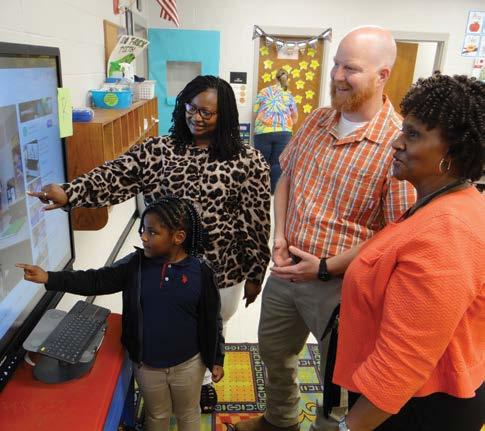
Students use the panels daily for reading, math, science, social studies and virtual field trips.
East Side Principal Jacqueline Gray said this sort of technology is a learning way of life now. “These kids belong to the technology generation. This is an example of the future. This is helping advance their young minds. It gives them a clear view of the world. They can see and express things that they may never get to express in person,” Gray explained.
The 4-County Foundation, she stressed, is an outstanding partner in education. “Without 4-County, we couldn’t a ord to have what we feel is the latest and greatest technology. This will open up a lot of learning opportunities for our students,” Gray added.


4-County believes in helping the communities it serves. That’s why the cooperative launched the 4-County Foundation, a community service program. Since February 2015, participating 4-County members’ utility bills have been rounded up to the nearest dollar; a $125.78 bill, for example, becomes $126. Now, that’s an average of only 49 cents per member, per month. That may not seem like much. But when you multiply those contributions by the thousands of member participants, that’s a lot of pennies! For more information on the 4-County Foundation, call 1-800-431-1544.


Two new employees have recently joined the 4-County/FASTnet team.
Colin Bell of Starkville has joined the FASTnet team as an Installer/Technician.
Prior to 4-County, Colin worked in the fiber optic communications industry, and he worked for two years as a project manager for AT&T.
Originally from Clinton, he has a Business Management degree from Mississippi State University. He is an Eagle Scout.

Colin attends Meadowview Baptist Church in Starkville where he serves as a deacon and as a volunteer leader for the college ministry. His hobbies include outdoor activities.
Ryan Wright of Starkville has joined the FASTnet team as a Network Analyst.
Prior to 4-County, Ryan worked two years as a project manager for Paul Jackson and Son General Contractors.

He graduated from East Mississippi Community College with a degree in Network Technologies.
Ryan’s wife, Amber, is a special education teacher in the Starkville area.
He is originally from Memphis, Tennessee. His hobbies include hiking, working on computers, and spending time with his family.
Welcome to the 4-County/FASTnet team!
Colin Bell Ryan Wright
A tradition of dependable, hometown service since 1937
 by Miranda Boutelle
by Miranda Boutelle
QI’m making an e ort to reduce my energy use, and I want my kids to start energy-saving habits as well. How can I encourage them to use less electricity at home?
Educating kids on energy use and costs can help engage them in your family’s goal to use less electricity. They can be electric conservation champions if you ask them to help. Here are some ways you can teach kids to use less electricity.
Show them how to read the electric bill. Focus on what you can control: kilowatt-hour use. If they are old enough, teach them how to do the math. You can calculate kWh use by multiplying wattage by hours used and dividing by 1,000. Multiply this by the kWh rate found on your electric bill to estimate how much you spend on power for each household appliance.
AWhen I was a kid, I dreamed of one day having a home where I could pay my own electric bill. Said no one ever. While it’s not the most fun way to spend money, people typically want to live in a home with electricity.
You can also leave the house during the hottest times of the day to go for a swim or play outside. Before you go, nudge up the thermostat a few degrees to avoid wasted energy cooling an empty house. Turn o fans when you leave a room.
The second-highest use of electricity is typically the electric water heater. Use a shower timer so bigger kids can monitor how long they are in the shower. Teach them to wash their clothes with cold water. If you have a gas water heater, look at the gas bill to find opportunities to save.

In the
For example, if you have a space heater that uses 1,500 watts and is on for four hours a day for a month, it uses 180 kWh. With an average kWh rate of 13.7 cents in the United States, the space heater costs about $25 a month to operate. That same space heater costs about $74 a month if it is on for 12 hours per day. Your kWh rate may be lower or higher depending on where you live.
keep
door shut. Teach kids to take a quick peek and shut the door while they think about their snack options.
For household appliance wattage, look for the amount stamped on the bottom, back, or nameplate. If the nameplate does not include wattage, figure it out by multiplying the voltage by the amperage.
To teach children the impact of saving energy, have them help you conserve with the household’s biggest energy-consuming appliances: heating and cooling. Teach kids to dress appropriately for the seasons, even when they are indoors, which allows you to set the thermostat to balance comfort and savings.
Other ways to save include turning o the lights when you leave the room. The more we switch to LED lighting, the less savings associated. Yet even little changes can add up throughout the year. If your child needs a nightlight to sleep with, make sure it’s an LED bulb.

Powering down gaming stations and computers is another way to save. In the kitchen, keep the refrigerator door shut. Teach kids to take a quick peek and shut the door while they think about their snack options.
After teaching your kids about electric bills and showing them how to save electricity, make a game out of your family’s energy conservation e orts. Challenge the family to use less energy than last month or the same month last year. Use the savings to reward them with a treat or let the winner pick the game night activity or film for family movie night.
Miranda Boutelle is the chief operating o cer at E ciency Services Group in Oregon, a cooperatively owned energy e ciency company.A group of 81 rising high school seniors from all over Mississippi traveled to Washington, D.C. in June to attend the 2023 NRECA Youth Tour.







The trip was the culmination of the students’ participation in the Electric Cooperatives of Mississippi’s youth leadership program.
The program instills leadership skills, inspires creative thinking, encourages community service, and introduces students to lawmakers that represent their communities.







During the March workshop in Jackson, the students had the opportunity to meet and hear from state legislators. During the trip to Washington, D.C., the students met and spoke with their U.S.
senators — Roger Wicker and Cindy Hyde-Smith — and two of their U.S. representatives, Mike Ezell and Michael Guest.






While in Washington, D.C., the students and adult chaperones visited historic sites, monuments, museums, explored Capitol Hill, and had an opportunity to learn about the impact electric cooperatives have on their communities.
The students were chosen by their local electric cooperative. The Cooperatives Youth Leaders program is fully funded — including the trip to D.C. — by the local electric co-ops as a commitment to molding future leaders for Mississippi so they can impact the state and local communities.



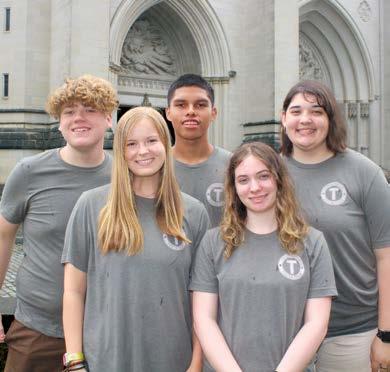
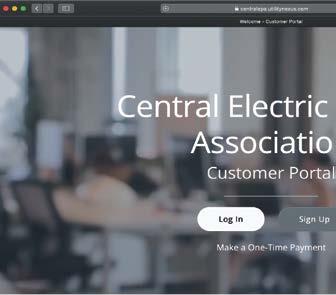



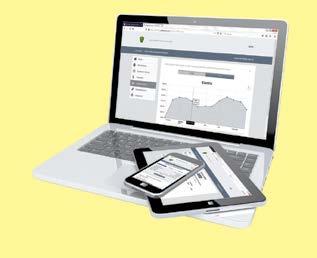
















Lord, you have brought us to a new school year. Keep our children safe as they travel to and from school and sporting events. I pray that each child is provided a healthy environment that promotes LOVE, fosters passion, and acceptance of their genuine individuality. Let negative words and comments roll o them and not take root in their souls. Give them wisdom as they face challenging situations. I look to your eternal faithfulness, remembering that they are yours from the beginning and you love them more. Guide them away from harm and grant your angels of protection around us all.
Thank you for our amazing teachers and administrators who have given their lives to serve our children. Continue







to mold them with LOVE in their hearts, wisdom, patience, and joy this upcoming school year. Give them strength to lead, grace to guide, and the desire to thrive.
Parents, I pray for strong and reliable support systems when overwhelming feeling consumes us. Help us mature as parents and caregivers while maintaining peace and discernment in our homes. Amid these trying and troubling times, guide us through the storms. Make us brave where we feel afraid and strong in the face of our weakness. Bless every family with your LOVE and goodness.
In Jesus’ name, Amen






appropriately for the seasons, even when they are indoors, which allows you to set the thermostat to balance comfort and savings.




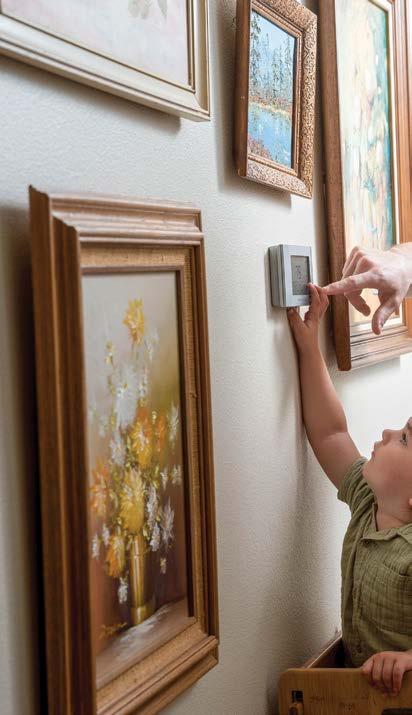 by Miranda Boutelle
by Miranda Boutelle
QI’m making an e ort to reduce my energy use, and I want my kids to start energy-saving habits as well. How can I encourage them to use less electricity at home?











AWhen I was a kid, I dreamed of one day having a home where I could pay my own electric bill. Said no one ever. While it’s not the most fun way to spend money, people typically want to live in a home with electricity.



Educating kids on energy use and costs can help engage them in your family’s goal to use less electricity. They can be electric conservation champions if you ask them to help. Here are some ways you can teach kids to use less electricity.
Show them how to read the electric bill. Focus on what you can control: kilowatt-hour use. If they are old enough, teach them how to do the math. You can calculate kWh use by multiplying wattage by hours used and dividing by 1,000. Multiply this by the kWh rate found on your electric bill to estimate how much you spend on power for each household appliance.
For example, if you have a space heater that uses 1,500 watts and is on for four hours a day for a month, it uses 180 kWh. With an average kWh rate of 13.7 cents in the United States, the space heater costs about $25 a month to operate. That same space heater costs about $74 a month if it is on for 12 hours per day. Your kWh rate may be lower or higher depending on where you live.




For household appliance wattage, look for the amount stamped on the bottom, back, or nameplate. If the nameplate does not include wattage, figure it out by multiplying the voltage by the amperage.
To teach children the impact of saving energy, have them help you conserve with the household’s biggest energy-consuming appliances: heating and cooling. Teach kids to dress appropriately for the seasons, even when they are indoors, which allows you to set the thermostat to balance comfort and savings.
You can also leave the house during the hottest times of the day to go for a swim or play outside. Before you go, nudge up the thermostat a few degrees to avoid wasted energy cooling an empty house. Turn o fans when you leave a room.
The second-highest use of electricity is typically the electric water heater. Use a shower timer so bigger kids can monitor how long they are in the shower. Teach them to wash their clothes with cold water. If you have a gas water heater, look at the gas bill to find opportunities to save.
In the kitchen, keep the refrigerator door shut. Teach kids to take a quick peek and shut the door while they think about their snack options.

Other ways to save include turning o the lights when you leave the room. The more we switch to LED lighting, the less savings associated. Yet even little changes can add up throughout the year. If your child needs a nightlight to sleep with, make sure it’s an LED bulb.
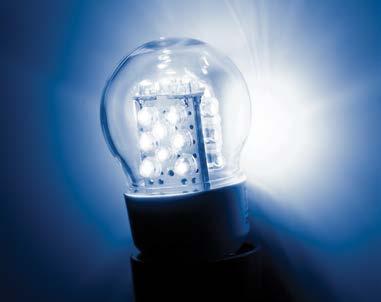
Powering down gaming stations and computers is another way to save. In the kitchen, keep the refrigerator door shut. Teach kids to take a quick peek and shut the door while they think about their snack options.
After teaching your kids about electric bills and showing them how to save electricity, make a game out of your family’s energy conservation e orts. Challenge the family to use less energy than last month or the same month last year. Use the savings to reward them with a treat or let the winner pick the game night activity or film for family movie night.
You can also teach children where the electricity for their home comes from. Check out your electric co-op’s website or give them a call to find out what energy sources power your home.
Miranda Boutelle is the chief operating o cer at E ciency Services Group in Oregon, a cooperatively owned energy e ciency company. In the kitchen, keep the refrigerator door shut. Teach kids to take a quick peek and shut the door while they think about their snack options.Charging is a crucial concern among new electric vehicle (EV) owners, whether plug-in hybrid or full electric. Fear of inconvenience is one of the biggest barriers to widespread adoption of electric vehicles. You might be concerned that there aren’t enough public charging stations in the area — and even if there are public charging stations nearby, do you really want to rely on them any time you need to refuel?
An EV charging station at home can solve this challenge of inconvenience. But are EV charging systems at home safe? Absolutely — as long as they’re installed correctly.
The first thing EV owners should consider is how they will charge their vehicles.
A licensed electrician can evaluate your home’s EV charging situation, as well as:
• The vehicle’s charging capabilities and requirements, which vary depending on the make, model and type





• The potential location of the panel and vehicle, including the distance from the panel to the garage, the degree of di culty and whether the garage is attached or detached
• The capacity and overall condition of your home electrical system to identify any concerns or additional work.





















There are two common types of home charging options. Level 1 charging is a straightforward plug-in of the EV into any standard 120V electrical outlet. This requires no electrical modification, and it normally takes around 14 to 20 hours to fully charge the EV.
Some EV manufacturers and sellers provide inaccurate information on charging, and some will suggest that a standard 120-volt outlet is all you need. Unfortunately, this degree of charging may not always match the driver’s daily travel needs.
Level 2 charging units are sold separately from the vehicle. These units must be installed by a licensed electrician because they plug into a 240V outlet and charge much more quickly, typically four to eight hours.

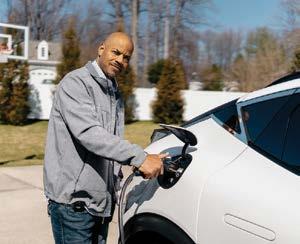
• Select charging equipment that is certified to meet safety standards. Plug Level I EV chargers directly into an outlet designed to handle the amperage of the charging device. Never use a multi-plug adapter or extension cord. Charging cables are a tripping hazard, so be aware of the cable’s location. Purchase a Level 2 charging device that is certified by a nationally recognized testing laboratory. This means the device has gone through rigorous testing and certification by a thirdparty company with extensive knowledge and pedigree in certifying EV technologies.
• Check with a licensed electrician before modifying your electrical system or installing a charging station. An electrician will need to make sure your home’s wiring complies with local, state and national codes, and may need to obtain a permit before installation.
• Place all charging components out of reach of children when not in use.
• Cover the EV charging station outlet to prevent water exposure. Check the manufacturer’s guidelines to make sure it is safe to charge your EV in wet conditions.
• Most charging stations are equipped with safety devices such as GFCIs, which will identify electrical shorts and stop power to the charger to minimize risks. There is a low risk of electric shock, but safeguards are automatically built into the equipment.
EV chargers are thought to be extremely safe, but we recommend following these fundamental guidelines to reduce potential hazards.
Where our members have

Some of the moments that make me most proud to be a coop employee are the ones that are also the most challenging. Co-ops are guided by a set of seven principles, one of which is cooperation among cooperatives. While this principle is used daily to strengthen our industry, it is perhaps the most important during times of crisis.
In June, when Southern Pine Electric had heavy damage from storms and tornadoes, our employees answered the call to help Southern Pine crews restore service to their members. A crew including line workers, engineers, safety personnel and vehicle maintenance employees traveled to Southern Pine territory to help fellow Mississippians recover and rebuild.
I am proud of their work and I am comforted to know that we have the strength of co-ops across the nation behind us in our time of need.
by Ron BarnesCoast Electric employees help restore service to Southern Pine Electric members after tornadoes caused heavy damage to their system.
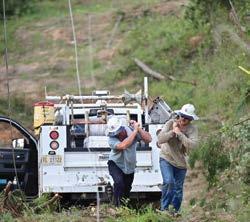

Coast Electric wants you to reduce your energy use and see savings on your monthly energy costs. Each month, you will have an opportunity to register to win a prize that will help you reduce energy consumption in your home.
Congratulations to Cynthia Wood, the winner of our June Reduce Your Use prize. Visit www.coastelectric.coop and fill out our entry form. It only takes a few seconds, and you could win a prize that helps you save!
President and CEOCharitable organizations that serve Hancock, Harrison and/or Pearl River counties could be eligible for a grant of up to $10,000 from Coast Electric’s Operation Round Up program. Grant applications are available online only through Aug. 31.
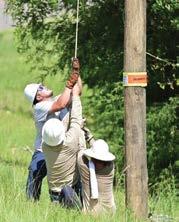
Grants are made possible by generous contributions from Coast Electric members who round their bill up to the nearest dollar each month. These contributions are responsible for funding more than $1 million in grants in our community!
Coast Electric works with the Gulf Coast Community Foundation to process and administer grants.



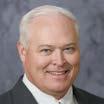

Visit https://coastelectric.coop/my-community/operation-roundup/ to apply.











Coast Connect is growing every day as more homes and businesses are choosing our world-class internet speeds and hometown service. To give our subscribers the best possible customer service experience, we are introducing a new subscriber information and accounting system.

As part of our transition to this new system: Beginning Aug. 2, all subscribers must create a profile for the new portal. Subscribers may reuse their current username and password for their profile or create new ones. Payments must be made using CoastConnect’s new portal for those choosing to make payments online. To access the portal, visit www.CoastConnect.com and click “Pay Bill.” You may also call 877-969-3884 to make a payment. CoastConnect subscribers will no longer be able to use Coast Electric payment methods to pay their bills. This update will bring our subscribers more convenient ways to pay.


We appreciate the patience and support of our subscribers as we update our system.













To keep waste and costs down for everyone, we are implementing paperless billing for all CoastConnect subscribers beginning Sept. 1. Your bill will have a new look and will be emailed to you. Your new e-bill will come from noreply@camvio.cloud so be sure to whitelist this account so you don’t miss your bill.
If you still want a paper bill, you can visit www.coastconnect.com/opt-out-paperlessbilling to opt out of paperless billing. You can also call 877-969-3884 and speak to a fiber service representative. If you choose to opt out, a $4 fee will be added to your monthly bill. We appreciate our the patience and support of our subscribers as we update our system.



Coast Electric recently updated its outage management system and online map. The update came with an upgrade and another convenient way for members to report outages. You can now report outages directly on our map. Visit http://outages.coastelectric.coop and click the red “Report Outage” button on the upper right side of the page.
Registration is open for our 2023 Annual Meeting! We hope to see you at the meeting on Nov. 2, but if you are unable to attend, you can register in one of three ways:
1. Return the registration card that was mailed to your home.



2. Register online through Oct. 27. Visit www.coastelectric.coop/annual-meeting-registration.





3. Register at any Coast Electric o ce by Oct. 27.
















Those who attend the meeting and those who register will be entered for a chance to win up to $1,000 in electricity credits!

D’Iberville is now home to a sustainable habitat for Monarch butterflies and pollinators thanks to a partnership between Coast Electric and the Land Trust for the Mississippi Coastal Plain (LTMCP).



The 44-acre property, located on West Gay Road, near the Promenade, has a nine-acre pond, dozens of large oak trees, cypress trees and a thriving ecosystem. Coast Electric employees from the Harrison County division have worked to improve the property and create a pollinator garden and Monarch Waystation to support ecological health in our community. The garden is certified and registered by Monarch Watch as an o cial Monarch Waystation.
There is an outdoor classroom on the property that will allow local schools, home school groups and the public to engage in hands-on learning that emphasizes the importance of environmental stewardship.
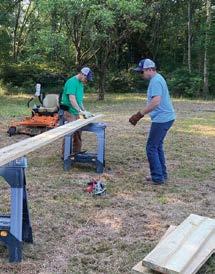

Coast Electric and LTMCP have worked as partners for more than 20 years to sustain and improve properties in our area. The mission of LTMCP is to conserve, promote and protect open spaces and green spaces of ecological, cultural or scenic significance.



Coast Electric is a local electric cooperative with guiding principles that emphasize community service and environmental stewardship.





“Partnering with the Land Trust gives our employees the opportunity to maintain and improve properties that may have otherwise been lost to neglect or misuse,” said Coast Electric Director of Community Development Janell Nolan. “The beauty of our community is one of the reasons we love living here. Our employees enjoy participating in these projects that keep Mississippi beautiful and make the outdoors more accessible to others.”
Mississippi beautiful and make the outdoors more accessible to others.”






Sponsors for the project include the Crosby Arboretum, which is also home to a pollinator garden, Coastline Home and Garden Supply, SunCoast Contractor Supply and the Mississippi State Extension Service. The Extension Service provided expertise about pollinators and plants to help sustain their habitat. The City of D’Iberville is providing clean water at the property to properly sustain the garden.
For information on how your community or school group can visit the garden, email info@ltmcp.org or community@coastelectric.coop.

 Coast Electric employees from the Harrison County division work to clear a property owned by the Land Trust for the Mississippi Coastal Plain. The property now houses a pollinator garden and a registered Monarch Waystation.
The community celebrates the o cial opening of the pollinator garden at the Schwan Property.
The 44-acre property, located in D’Iberville, features a nine-acre pond and an outdoor classroom in addition to the pollinator garden.
Coast Electric employees from the Harrison County division work to clear a property owned by the Land Trust for the Mississippi Coastal Plain. The property now houses a pollinator garden and a registered Monarch Waystation.
The community celebrates the o cial opening of the pollinator garden at the Schwan Property.
The 44-acre property, located in D’Iberville, features a nine-acre pond and an outdoor classroom in addition to the pollinator garden.
A group of 81 rising high school seniors from all over Mississippi traveled to Washington, D.C., in June to attend the 2023 NRECA Youth Tour.









The trip was the culmination of the students’ participation in the Electric Cooperatives of Mississippi’s youth leadership program.




The program instills leadership skills, inspires creative thinking, encourages community service, and introduces students to lawmakers who represent their communities.










During a workshop in Jackson last March, the students had the opportunity to meet and hear from state legislators. During the trip to Washington, D.C., the students met and spoke with their U.S. senators — Roger Wicker and Cindy HydeSmith — and two of their U.S. representatives, Mike Ezell and Michael Guest.
While in Washington, D.C., the students visited historic sites, monuments, museums, explored Capitol Hill, and had an opportunity to learn about the impact electric cooperatives have on their communities.
The Cooperatives Youth Leaders program is fully funded by the local electric co-ops as a commitment to molding future leaders for Mississippi so they can impact the state and local communities.


I was recently asked about what exactly impacts residential electricity prices. We talked about how the daily cost of living seems to have increased across the board.
Just as inflation has impacted everything from the price of gasoline to the price of eggs, costs for the fuels required to produce electricity have also risen. This is a timely topic, so I wanted to help explain some of the factors that impact residential electricity prices (and energy bills) in this month’s issue of Today in Mississippi.



While there is no short answer, there are a few key elements that impact residential electricity prices and rates. Some of these factors Delta Electric can manage, some of them you can control, and other factors are beyond our control. So, let me break it down.
There are three primary parts to your monthly electric bill: a service charge, an energy consumption/kWh charge, and a Power Cost Adjustment or PCA. To understand your total energy costs and what a ects your residential bill, lets unpack it one piece at a time.

The first is a fixed monthly service charge, which covers the costs associated with providing electricity to your home. This includes equipment, materials, labor, and operating costs necessary to serve each meter in Delta Electric’s service territory, regardless of the amount of energy used. In order to ensure the reliable service, you expect and deserve, we must maintain our electric distribution system, including power lines, substations, and other necessary equipment. Like many other businesses, we’ve experienced supply chain issues and steep cost increases for some of our basic equipment. For example, the cost for a distribution transformer (which looks like a metal can at the top of a power pole) went up to $2,300 this year and wait times to receive this essential equipment are up to 52 weeks. Because we are a not-for-profit cooperative, some of these expenses must be passed on to our members. I should note that the service charge is the same for every residential customer and the costs are shared equally across the membership.
Another component of your monthly bill is the kWh charge, which covers how much energy you consume. You’ve likely noticed the amount of energy you use can vary from month to month and is






typically impacted by extreme temperatures. When temperatures soar or dip, your cooling and heating equipment run longer, which increases your home energy use. Regardless, energy consumption is an area that you have some control over, and you can lower your monthly bill by actively reducing energy use. Your thermostat is a great place to start, so be sure to keep it close to 78 degrees during summer months.
The last component of your bill is the PCA or Power Cost Adjustment, which is the same amount for all co-op members. The PCA recently increased because of higher fuel prices, which means the power that Delta Electric purchases from our wholesale provider is more expensive. The PCA covers fuel cost fluctuations without having to continually restructure electricity rates and Delta Electric’s PCA adjusts monthly in order to smooth out fluctuations in fuel prices.
I hope this information sheds light on some of the factors that impact electricity prices. While we can’t control the weather or the rising costs of fuels, please know Delta Electric is doing everything possible to keep internal costs down.


















appropriately for the seasons, even when they are indoors, which allows you to set the thermostat to balance comfort and savings.




 by Miranda Boutelle
by Miranda Boutelle
QI’m making an e ort to reduce my energy use, and I want my kids to start energy-saving habits as well. How can I encourage them to use less electricity at home?











AWhen I was a kid, I dreamed of one day having a home where I could pay my own electric bill. Said no one ever. While it’s not the most fun way to spend money, people typically want to live in a home with electricity.



Educating kids on energy use and costs can help engage them in your family’s goal to use less electricity. They can be electric conservation champions if you ask them to help. Here are some ways you can teach kids to use less electricity.
Show them how to read the electric bill. Focus on what you can control: kilowatt-hour use. If they are old enough, teach them how to do the math. You can calculate kWh use by multiplying wattage by hours used and dividing by 1,000. Multiply this by the kWh rate found on your electric bill to estimate how much you spend on power for each household appliance.
For example, if you have a space heater that uses 1,500 watts and is on for four hours a day for a month, it uses 180 kWh. With an average kWh rate of 13.7 cents in the United States, the space heater costs about $25 a month to operate. That same space heater costs about $74 a month if it is on for 12 hours per day. Your kWh rate may be lower or higher depending on where you live.




For household appliance wattage, look for the amount stamped on the bottom, back, or nameplate. If the nameplate does not include wattage, figure it out by multiplying the voltage by the amperage.
To teach children the impact of saving energy, have them help you conserve with the household’s biggest energy-consuming appliances: heating and cooling. Teach kids to dress appropriately for the seasons, even when they are indoors, which allows you to set the thermostat to balance comfort and savings.
You can also leave the house during the hottest times of the day to go for a swim or play outside. Before you go, nudge up the thermostat a few degrees to avoid wasted energy cooling an empty house. Turn o fans when you leave a room.
The second-highest use of electricity is typically the electric water heater. Use a shower timer so bigger kids can monitor how long they are in the shower. Teach them to wash their clothes with cold water. If you have a gas water heater, look at the gas bill to find opportunities to save.
In the kitchen, keep the refrigerator door shut. Teach kids to take a quick peek and shut the door while they think about their snack options.

Other ways to save include turning o the lights when you leave the room. The more we switch to LED lighting, the less savings associated. Yet even little changes can add up throughout the year. If your child needs a nightlight to sleep with, make sure it’s an LED bulb.

Powering down gaming stations and computers is another way to save. In the kitchen, keep the refrigerator door shut. Teach kids to take a quick peek and shut the door while they think about their snack options.
After teaching your kids about electric bills and showing them how to save electricity, make a game out of your family’s energy conservation e orts. Challenge the family to use less energy than last month or the same month last year. Use the savings to reward them with a treat or let the winner pick the game night activity or film for family movie night.
You can also teach children where the electricity for their home comes from. Check out your electric co-op’s website or give them a call to find out what energy sources power your home.
Miranda Boutelle is the chief operating o cer at E ciency Services Group in Oregon, a cooperatively owned energy e ciency company. In the kitchen, keep the refrigerator door shut. Teach kids to take a quick peek and shut the door while they think about their snack options.Charging is a crucial concern among new electric vehicle (EV) owners, whether plug-in hybrid or full electric. Fear of inconvenience is one of the biggest barriers to widespread adoption of electric vehicles. You might be concerned that there aren’t enough public charging stations in the area — and even if there are public charging stations nearby, do you really want to rely on them any time you need to refuel?
An EV charging station at home can solve this challenge of inconvenience. But are EV charging systems at home safe? Absolutely — as long as they’re installed correctly.
The first thing EV owners should consider is how they will charge their vehicles.
A licensed electrician can evaluate your home’s EV charging situation, as well as:
• The vehicle’s charging capabilities and requirements, which vary depending on the make, model and type





• The potential location of the panel and vehicle, including the distance from the panel to the garage, the degree of di culty and whether the garage is attached or detached
• The capacity and overall condition of your home electrical system to identify any concerns or additional work.





















There are two common types of home charging options. Level 1 charging is a straightforward plug-in of the EV into any standard 120V electrical outlet. This requires no electrical modification, and it normally takes around 14 to 20 hours to fully charge the EV.
Some EV manufacturers and sellers provide inaccurate information on charging, and some will suggest that a standard 120-volt outlet is all you need. Unfortunately, this degree of charging may not always match the driver’s daily travel needs.
Level 2 charging units are sold separately from the vehicle. These units must be installed by a licensed electrician because they plug into a 240V outlet and charge much more quickly, typically four to eight hours.


• Select charging equipment that is certified to meet safety standards. Plug Level I EV chargers directly into an outlet designed to handle the amperage of the charging device. Never use a multi-plug adapter or extension cord. Charging cables are a tripping hazard, so be aware of the cable’s location. Purchase a Level 2 charging device that is certified by a nationally recognized testing laboratory. This means the device has gone through rigorous testing and certification by a thirdparty company with extensive knowledge and pedigree in certifying EV technologies.
• Check with a licensed electrician before modifying your electrical system or installing a charging station. An electrician will need to make sure your home’s wiring complies with local, state and national codes, and may need to obtain a permit before installation.
• Place all charging components out of reach of children when not in use.
• Cover the EV charging station outlet to prevent water exposure. Check the manufacturer’s guidelines to make sure it is safe to charge your EV in wet conditions.
• Most charging stations are equipped with safety devices such as GFCIs, which will identify electrical shorts and stop power to the charger to minimize risks. There is a low risk of electric shock, but safeguards are automatically built into the equipment.
EV chargers are thought to be extremely safe, but we recommend following these fundamental guidelines to reduce potential hazards.
In the coming weeks, you will begin to see information arriving in your inbox and mailbox asking you to participate in our annual board elections. I want to take this opportunity to emphasize the significant impact your participation can have on shaping the future of our cooperative and community. I firmly believe that our cooperative’s strength lies in the active involvement of its members, and that is why I ask you to exercise your right to vote in our upcoming annual board elections. Your vote matters, and here’s why.

Dixie Electric operates on the principles of democracy and member ownership. By casting your vote, you actively participate in the decisionmaking process, ensuring that the cooperative is aligned with the collective interests of its members. This fundamental principle sets us apart from other energy providers; We’re a co-op, and our business model is meant to serve the members and the community in which it operates — not to make a profit for stockholders who, for the most part, don’t even live here.


One of the most crucial aspects of our annual meeting is the election of board members. The board of directors plays a vital role in setting policies, providing guidance to management, and safeguarding the cooperative’s long-term sustainability. By voting for the right candidates, you ensure that the board reflects our membership’s diverse interests and expertise, ultimately leading to informed decision-making and e ective governance. One question we receive regularly is why your vote matters if there is only one candidate on the ballot. Even if only one candidate seeks election, the
membership must still elect that candidate, and our bylaws require that at least 10% of the membership must participate to be able to hold the annual meeting and direction election.













Voting in the annual meeting strengthens the relationship between the cooperative and its members. Your vote is a direct expression of trust in our cooperative’s governance and leadership. By participating in the annual meeting, you signal your confidence in the transparency of our decisionmaking processes and your belief in our commitment to serving the best interests of our members. This trust is the foundation upon which we can continue to build a cooperative that meets the evolving needs of our members and community.
Each year, the annual meeting represents a pivotal moment for our cooperative and its members. We recognize the vital role Dixie Electric plays in our community. Your participation ensures that the cooperative remains responsive, innovative, and accountable to the collective interests of its members. Remember, every vote counts, and your vote matters. So, mark your calendars for the opening day of online voting Monday, August 21, and make your voice count in the next annual board elections.
by Randy Smith General Manager“Powering communities and empowering lives” Dixie Electric is an equal opportunity employer and provider.











A group of 81 rising high school seniors from all over Mississippi traveled to Washington, D.C. in June to attend the 2023 NRECA Youth Tour.









The trip was the culmination of the students' participation in the Electric Cooperatives of Mississippi’s youth leadership program.
The program instills leadership skills, inspires creative thinking, encourages community service, and introduces students to lawmakers that represent their communities.


During the March workshop in Jackson, the students had the opportunity to meet and hear from state legislators. During the trip to Washington, D.C., the students met and spoke with their U.S. senators — Roger Wicker and Cindy HydeSmith — and two of their U.S. representatives, Mike Ezell and Michael Guest.
While in Washington, D.C., the students and adult chaperones visited historic sites, monuments, museums, explored Capitol Hill, and had an opportunity to learn about the impact electric cooperatives have on their communities.
The students were chosen by their local electric cooperative.
The Cooperatives Youth Leaders program is fully funded — including the trip to D.C. — by the local electric co-ops as a commitment to molding future leaders for Mississippi so they can impact the state and local communities.
 Pictured right: Top: Dixie Electric Youth Tour students Bella Lane and Dillon Burnham stand in front of the White House. Bottom: Bell Lane and Dillon Burnham in front of Washington National Cathedral.
Pictured right: Top: Dixie Electric Youth Tour students Bella Lane and Dillon Burnham stand in front of the White House. Bottom: Bell Lane and Dillon Burnham in front of Washington National Cathedral.
Right-of-way maintenance is one of the best things we can do to provide the reliability that our members have come to expect. Our 26 substations are trimmed on a six-year rotation. For 2023, we are trimming Macedonia, Diamond, West Richton, and Cleo substations, which will total just shy of 1,000 miles of right-of-way.
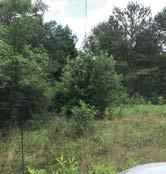


By keeping our rights-of-way trimmed, we can prevent outages, maintain safety, improve e ciency, and enhance the resilience of our electric system.























 Bobby Sims Dr. Wayne County - Before
Bobby Sims Dr. Wayne County - After
Bobby Sims Dr. Wayne County - Before
Hwy 84 East Wayne County - Before
Hwy 84 East Wayne County - Before
West Cedar Ridge Rd. Wayne County - Before
West Cedar Ridge Rd. Wayne County - Before
West Cedar Ridge Rd. Wayne County - Before
Quail Dr. - Before
West Cedar Ridge Rd. Wayne County - After
West Cedar Ridge Rd. Wayne County - After
West Cedar Ridge Rd. Wayne County - After
Quail Dr. - After
Hwy 84 East Wayne County - After
Hwy 84 East Wayne County - After
Bobby Sims Dr. Wayne County - After
West Cedar Ridge Rd. Wayne County - Before
Bobby Sims Dr. Wayne County - Before
Bobby Sims Dr. Wayne County - After
Bobby Sims Dr. Wayne County - Before
Hwy 84 East Wayne County - Before
Hwy 84 East Wayne County - Before
West Cedar Ridge Rd. Wayne County - Before
West Cedar Ridge Rd. Wayne County - Before
West Cedar Ridge Rd. Wayne County - Before
Quail Dr. - Before
West Cedar Ridge Rd. Wayne County - After
West Cedar Ridge Rd. Wayne County - After
West Cedar Ridge Rd. Wayne County - After
Quail Dr. - After
Hwy 84 East Wayne County - After
Hwy 84 East Wayne County - After
Bobby Sims Dr. Wayne County - After
West Cedar Ridge Rd. Wayne County - Before

Follow these tips to BEAT THE HEAT and save on your August electric bill:


DE Fastlink offers A+ internet plans with speeds up to 1 Gig, and they all include responsive customer service and support by our local team, no data caps, and no hidden fees.
DE Fastlink offers A+ internet plans with speeds up to 1 Gig, and they all include responsive customer service and support by our local team, no data caps, and no hidden fees.
DE Fastlink offers A+ internet plans with speeds up to 1 Gig, and they all include responsive customer service and support by our local team, no data caps, and no hidden fees.
DE Fastlink offers A+ internet plans with speeds up to 1 Gig, and they all include responsive customer service and support by our local team, no data caps, and no hidden fees.
OPTIMIZE YOUR THERMOSTAT:
GET BIGGER INTERNET SPEEDS
GET BIGGER INTERNET SPEEDS
DE Fastlink offers A+ internet plans with speeds up to 1 Gig, and they all include responsive customer service and support by our local team, no data caps, and no hidden fees.


Set your thermostat to the highest setting possible when home and set the temp a few degrees higher when you’re away.

VISIT DEFASTLINK.NET OR CALL 833-521-3278
GET BIGGER INTERNET SPEEDS
VISIT DEFASTLINK.NET OR CALL 833-521-3278
GET BIGGER INTERNET SPEEDS
VISIT DEFASTLINK.NET OR CALL 833-521-3278
GET BIGGER INTERNET SPEEDS
VISIT DEFASTLINK.NET OR CALL 833-521-3278
VISIT DEFASTLINK.NET OR CALL 833-521-3278
GET YOUR FANS ON:
Use ceiling fans to circulate the air and to cool o instead of turning your thermostat lower. Just remember to turn the ceiling fan o when leaving the room.

Margarett Boyd
Stan Gipson
Casey Adams
Sheree Ishee
James Bender
Charlotte Doherty
B.J. Cooley
The Credentials and Elections Committee verifies candidate qualifications for Dixie Electric’s board of director elections and oversees the voting process.
KEEP THE HEAT OUT:

Use blinds or curtains to keep the sun’s heat from infiltrating your home.

SEAL AIR LEAKS:
Caulk around doors and windows to ensure you keep the cool air in and the warm air out!


AIR FILTERS MATTER:
Change your air filter monthly to improve air flow and enhance your air conditioners performance.













Recently we made our annual trip to the beach with our sons, daughters-in-law, and grandkids. We had a wonderful time, and I am already looking forward to next year. I have always enjoyed the quiet times on the beach spent thinking about life and what is important.
Over the last few years, I have developed a routine of waking up early, loading up our beach chairs and umbrellas, and picking a spot close to the water to set up. It allows the family to enjoy being next to the water with a space for the kids to play on the sand. Once everything is positioned, I like to sit down, look across the water, and enjoy the quiet of the morning before everyone else starts arriving.
I then walk the nearly half a mile back to the beach house from the shore. By then, the grandkids are up and playing. We prepare co ee and breakfast appreciating each other’s company. After all of us have eaten, we walk to the beach and enjoy the morning.


Just before lunch, and as the heat of the day starts, we make the walk back to the house for lunch and one of the most enjoyable parts of the day – naptime. Some of us will return to the beach earlier than others, but when everyone is back the wave jumping and sandcastle building begin again.
These trips have taught me several lessons:

Lesson 1 – If you want the best view, you need to get up and do the work early. About mid-morning the late arrivals begin looking for places to put their chairs and umbrellas. By this time, the shoreline real estate has been taken.
Lesson 2 – Keep your music volume low. I am always amazed in this day of technology why some still bring their “boom” boxes to the beach. While most of the music shared was enjoyable, the peaceful


sounds of the waves are much more relaxing.


Lesson 3 – Take a thick skin. Not everyone uses appropriate language on the beach today. By being there early, we were able to avoid most of this and keep our grandkids insulated from it.

Lesson 4 – No sandcastle is important enough to worry about grandkids stomping it as soon as it is built. The laughs and squeals are much more important and priceless.
Lesson 5 – Cooking on the grill or in the kitchen of the house is much more enjoyable than waiting in long lines at a restaurant. You can cook what the grandkids prefer as they share all the things that pop into their little minds.
After supper, while the grandkids are getting their baths and preparing for bed, I return to the beach to retrieve the chairs and umbrellas. I like to sit down again after the crowds have gone and enjoy the view one more time before the day ends. Finally, I will load everything into the truck and look forward to tomorrow.
Beach lessons can be life lessons as well. If we do what it takes to prepare ourselves for each day, put in the necessary work to be successful, focus on serving others and spend quality time with family, life can and will be full of happiness and joy.
by Randy Carroll CEO — East Mississippi Electric Power AssociationA group of 81 rising high school seniors from all over Mississippi traveled to Washington, D.C. in June to attend the 2023 NRECA Youth Tour.







The trip was the culmination of the students’ participation in the Electric Cooperatives of Mississippi’s youth leadership program.
The program instills leadership skills, inspires creative thinking, encourages community service, and introduces students to lawmakers that represent their communities.







During the March workshop in Jackson, the students had the opportunity to meet and hear from state legislators. During the trip to Washington, D.C., the students met and spoke with their U.S.
senators — Roger Wicker and Cindy Hyde-Smith — and two of their U.S. representatives, Mike Ezell and Michael Guest.






While in Washington, D.C., the students and adult chaperones visited historic sites, monuments, museums, explored Capitol Hill, and had an opportunity to learn about the impact electric cooperatives have on their communities.
The students were chosen by their local electric cooperative. The Cooperatives Youth Leaders program is fully funded — including the trip to D.C. — by the local electric co-ops as a commitment to molding future leaders for Mississippi so they can impact the state and local communities.

QI’m making an e ort to reduce my energy use, and I want my kids to start energy-saving habits as well. How can I encourage them to use less electricity at home?





Educating kids on energy use and costs can help engage them in your family’s goal to use less electricity. They can be electric conservation champions if you ask them to help. Here are some ways you can teach kids to use less electricity.
Show them how to read the electric bill. Focus on what you can control: kilowatt-hour use. If they are old enough, teach them how to do the math. You can calculate kWh use by multiplying wattage by hours used and dividing by 1,000. Multiply this by the kWh rate found on your electric bill to estimate how much you spend on power for each household appliance.
For example, if you have a space heater that uses 1,500 watts and is on for four hours a day for a month, it uses 180 kWh. With an average kWh rate of 13.7 cents in the United States, the space heater costs about $25 a month to operate. That same space heater costs about $74 a month if it is on for 12 hours per day. Your kWh rate may be lower or higher depending on where you live.

AWhen I was a kid, I dreamed of one day having a home where I could pay my own electric bill. Said no one ever. While it’s not the most fun way to spend money, people typically want to live in a home with electricity.





You can also leave the house during the hottest times of the day to go for a swim or play outside. Before you go, nudge up the thermostat a few degrees to avoid wasted energy cooling an empty house. Turn o fans when you leave a room.
The second-highest use of electricity is typically the electric water heater. Use a shower timer so bigger kids can monitor how long they are in the shower. Teach them to wash their clothes with cold water. If you have a gas water heater, look at the gas bill to find opportunities to save.

In the kitchen, keep the refrigerator door shut. Teach kids to take a quick peek and shut the door while they think about their snack options.
For household appliance wattage, look for the amount stamped on the bottom, back, or nameplate. If the nameplate does not include wattage, figure it out by multiplying the voltage by the amperage.






To teach children the impact of saving energy, have them help you conserve with the household’s biggest energy-consuming appliances: heating and cooling. Teach kids to dress appropriately for the seasons, even when they are indoors, which allows you to set the thermostat to balance comfort and savings.
Other ways to save include turning o the lights when you leave the room. The more we switch to LED lighting, the less savings associated. Yet even little changes can add up throughout the year. If your child needs a nightlight to sleep with, make sure it’s an LED bulb.

Powering down gaming stations and computers is another way to save. In the kitchen, keep the refrigerator door shut. Teach kids to take a quick peek and shut the door while they think about their snack options.
After teaching your kids about electric bills and showing them how to save electricity, make a game out of your family’s energy conservation e orts. Challenge the family to use less energy than last month or the same month last year. Use the savings to reward them with a treat or let the winner pick the game night activity or film for family movie night.

A group of 81 rising high school seniors from all over Mississippi traveled to Washington, D.C. in June to attend the 2023 NRECA Youth Tour.







The trip was the culmination of the students’ participation in the Electric Cooperatives of Mississippi’s youth leadership program.
The program instills leadership skills, inspires creative thinking, encourages community service, and introduces students to lawmakers that represent their communities.








During the March workshop in Jackson, the students had the opportunity to meet and hear from state legislators. During the trip to Washington, D.C., the students met and spoke with their U.S.
senators — Roger Wicker and Cindy Hyde-Smith — and two of their U.S. representatives, Mike Ezell and Michael Guest.





While in Washington, D.C., the students and adult chaperones visited historic sites, monuments, museums, explored Capitol Hill, and had an opportunity to learn about the impact electric cooperatives have on their communities.
The students were chosen by their local electric cooperative. The Cooperatives Youth Leaders program is fully funded — including the trip to D.C. — by the local electric co-ops as a commitment to molding future leaders for Mississippi so they can impact the state and local communities.

If you have an upcoming junior-age student that would be interested in this program, please encourage them to talk to their school counselor now to compete in the fall. The Youth Leadership Program is all about leadership, education, and growth mixed with a ton of fun! It is a tough competition, but for the ones that win, it could possibly change their lives. For more pictures, please go to your local social media and use these hashtags: #YTDC23 #MS2DC #MSCYL #MSCYL23



























Monroe County was recently asked about what exactly impacts electricity prices. We talked about how the daily cost of living seems to have increased across the board.
Just as inflation has impacted everything from the price of gasoline to the price of eggs, costs for the fuels required to produce electricity have also risen. This is a timely topic, so we wanted to help explain some of the factors that impact electricity prices (and energy bills) in this month’s issue of Today in Mississippi.
While there is no short answer, there are a few key elements that impact electricity prices and rates. Some of these factors Monroe County can manage, some of them you can impact, and other factors are beyond our control. So, let me break it down.

There are three primary parts to your monthly electric bill: a service charge, an energy consumption/kWh charge, and a Power Cost Adjustment or PCA. To understand your total energy costs and what impacts your bill, lets unpack one piece at a time.
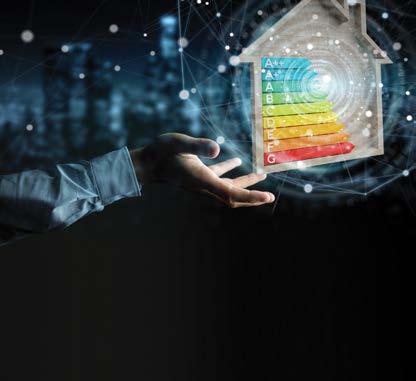
The first is a fixed monthly service charge, which covers the costs associated with providing electricity to your home. This includes equipment, materials, labor, and operating costs necessary to serve each meter in Monroe County’s service territory, regardless of the amount of energy used. In order to ensure the reliable service you expect and deserve, we must maintain the local system, including power lines, substations, and other necessary equipment. Like many other businesses, we’ve experienced supply chain issues and steep cost increases for some of our basic equipment. For example, the cost for a distribution transformer (which looks like a long metal can at the top of a power pole) went up to $2,400 this year, and wait times to receive this essential equipment are up to 20 weeks. Because we are a not-for-profit cooperative, some of these expenses must be passed on to our members. I should note that the service charge is the same for everyone and the costs are shared equally across the membership.
Another component of your monthly bill is the kWh charge, which covers how much energy you consume. You’ve likely noticed the amount of energy you use can vary from month to month and is typically impacted by extreme temperatures. When temperatures soar or dip, your cooling and heating equipment run longer, which increases your home energy use. Regardless, energy consumption is an area that you have some control over, and you can lower your monthly bill by
actively reducing energy use. Your thermostat is a great place to start, so be sure to keep it close to 78 degrees during summer months.
The last component of your bill is the PCA, which is the same amount for all co-op members. The PCA recently increased because of higher fuel prices, which means the power that Monroe County purchases from our wholesale provider is more expensive. The PCA covers fuel cost fluctuations without having to continually restructure electricity rates.
We hope this information sheds light on some of the factors that impact electricity prices. While we can’t control the weather or the rising costs of fuels, please know Monroe County is doing everything possible to keep internal costs down.








1) Fixed monthly service charge




2) Energy consumption/kWh charge

3) Power Cost Adjustment

appropriately for the seasons, even when they are indoors, which allows you to set the thermostat to balance comfort and savings.





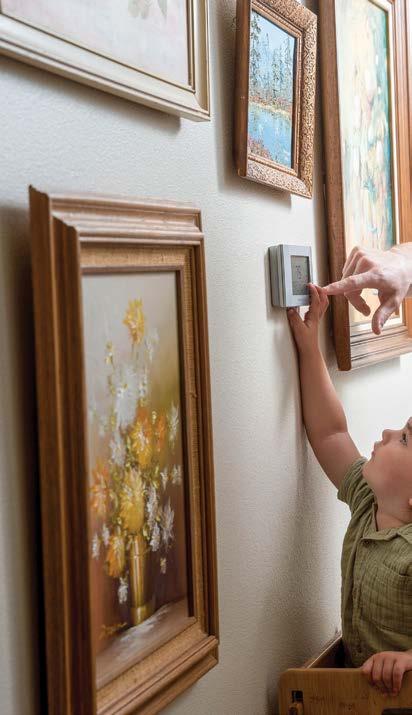 by Miranda Boutelle
by Miranda Boutelle

QI’m making an e ort to reduce my energy use, and I want my kids to start energy-saving habits as well. How can I encourage them to use less electricity at home?











AWhen I was a kid, I dreamed of one day having a home where I could pay my own electric bill. Said no one ever. While it’s not the most fun way to spend money, people typically want to live in a home with electricity.



Educating kids on energy use and costs can help engage them in your family’s goal to use less electricity. They can be electric conservation champions if you ask them to help. Here are some ways you can teach kids to use less electricity.
Show them how to read the electric bill. Focus on what you can control: kilowatt-hour use. If they are old enough, teach them how to do the math. You can calculate kWh use by multiplying wattage by hours used and dividing by 1,000. Multiply this by the kWh rate found on your electric bill to estimate how much you spend on power for each household appliance.
For example, if you have a space heater that uses 1,500 watts and is on for four hours a day for a month, it uses 180 kWh. With an average kWh rate of 13.7 cents in the United States, the space heater costs about $25 a month to operate. That same space heater costs about $74 a month if it is on for 12 hours per day. Your kWh rate may be lower or higher depending on where you live.




For household appliance wattage, look for the amount stamped on the bottom, back, or nameplate. If the nameplate does not include wattage, figure it out by multiplying the voltage by the amperage.
To teach children the impact of saving energy, have them help you conserve with the household’s biggest energy-consuming appliances: heating and cooling. Teach kids to dress appropriately for the seasons, even when they are indoors, which allows you to set the thermostat to balance comfort and savings.
You can also leave the house during the hottest times of the day to go for a swim or play outside. Before you go, nudge up the thermostat a few degrees to avoid wasted energy cooling an empty house. Turn o fans when you leave a room.
The second-highest use of electricity is typically the electric water heater. Use a shower timer so bigger kids can monitor how long they are in the shower. Teach them to wash their clothes with cold water. If you have a gas water heater, look at the gas bill to find opportunities to save.
In the kitchen, keep the refrigerator door shut. Teach kids to take a quick peek and shut the door while they think about their snack options.

Other ways to save include turning o the lights when you leave the room. The more we switch to LED lighting, the less savings associated. Yet even little changes can add up throughout the year. If your child needs a nightlight to sleep with, make sure it’s an LED bulb.

Powering down gaming stations and computers is another way to save. In the kitchen, keep the refrigerator door shut. Teach kids to take a quick peek and shut the door while they think about their snack options.
After teaching your kids about electric bills and showing them how to save electricity, make a game out of your family’s energy conservation e orts. Challenge the family to use less energy than last month or the same month last year. Use the savings to reward them with a treat or let the winner pick the game night activity or film for family movie night.
You can also teach children where the electricity for their home comes from. Check out your electric co-op’s website or give them a call to find out what energy sources power your home.
Miranda Boutelle is the chief operating o cer at E ciency Services Group in Oregon, a cooperatively owned energy e ciency company.
Charging is a crucial concern among new electric vehicle (EV) owners, whether plug-in hybrid or full electric. Fear of inconvenience is one of the biggest barriers to widespread adoption of electric vehicles. You might be concerned that there aren’t enough public charging stations in the area — and even if there are public charging stations nearby, do you really want to rely on them any time you need to refuel?
An EV charging station at home can solve this challenge of inconvenience. But are EV charging systems at home safe? Absolutely — as long as they’re installed correctly.
The first thing EV owners should consider is how they will charge their vehicles. A licensed electrician can evaluate your home’s EV charging situation, as well as:
• The vehicle’s charging capabilities and requirements, which vary depending on the make, model and type





• The potential location of the panel and vehicle, including the distance from the panel to the garage, the degree of difficulty and whether the garage is attached or detached




• The capacity and overall condition of your home electrical system to identify any concerns or additional work.

















There are two common types of home charging options. Level 1 charging is a straightforward plug-in of the EV into any standard 120V electrical outlet. This requires no electrical modification, and it normally takes around 14 to 20 hours to fully charge the EV.
Some EV manufacturers and sellers provide inaccurate information on charging, and some will suggest that a standard 120-volt outlet is all you need. Unfortunately, this degree of charging may not always match the driver’s daily travel needs.
Level 2 charging units are sold separately from the vehicle. These units must be installed by a licensed electrician because they plug into a 240V outlet and charge much more quickly, typically four to eight hours.


• Select charging equipment that is certified to meet safety standards. Plug Level I EV chargers directly into an outlet designed to handle the amperage of the charging device. Never use a multi-plug adapter or extension cord. Charging cables are a tripping hazard, so be aware of the cable’s location. Purchase a Level 2 charging device that is certified by a nationally recognized testing laboratory. This means the device has gone through rigorous testing and certification by a thirdparty company with extensive knowledge and pedigree in certifying EV technologies.
• Check with a licensed electrician before modifying your electrical system or installing a charging station. An electrician will need to make sure your home’s wiring complies with local, state and national codes, and may need to obtain a permit before installation.
• Place all charging components out of reach of children when not in use.
• Cover the EV charging station outlet to prevent water exposure. Check the manufacturer’s guidelines to make sure it is safe to charge your EV in wet conditions.
• Most charging stations are equipped with safety devices such as GFCIs, which will identify electrical shorts and stop power to the charger to minimize risks. There is a low risk of electric shock, but safeguards are automatically built into the equipment.
EV chargers are thought to be extremely safe, but we recommend following these fundamental guidelines to reduce potential hazards.
Per usual, the summer has flown by, and a new school year is approaching. I’ve always felt that communities are defined by their local school, and we have many quality ones in our area. We’ll soon see students, teachers, and adults renew friendships that saw a summer pause. These communities are often identified by driving down local roads on a Friday night and seeing the lights illuminating not only from the football field, but also the community of athletes, students, and followers in attendance. The return of the school year always seems to strengthen communities.
On the topic of lighting communities, Northcentral is pleased to see construction of fiber optic cable in the Marianna and Chulahoma communities. A ordable high-speed internet has quickly become a necessity like electricity in the 1930s. If you live in those areas, make sure to look at Northcentral Connect’s website and sign up for fantastic service.

Even though our community has had a hot summer, we’ve not approached the extreme temperatures and high electric bills we had last year. Bills on average are down significantly from last July. Slightly lower temperatures, and a decrease in generation fuel volatility have been a tremendous benefit.

Reliability remains high as well. The increased overall maintenance of our distribution grid through right of way clearing and the replacement of poles has really paid o . Your electric cooperative continues to do all it can to limit the interruption of power. We do, however, continue to push back on plans to scuttle useful generation assets without adequate plans to promptly replace them. Supply chain issues remain a concern, especially in the Southeast, as we enter the heart of hurricane season.
Let’s face it. August will be busy. Regional reliability concerns, coupled with the stress of an upcoming school year and a hot August can make things tense. Breathe deeply, check on a neighbor, drink water, make sure others drink water, and contact us if you need us.



 by Kevin Doddridge General Manager/CEO
by Kevin Doddridge General Manager/CEO










A group of 81 rising high school seniors from all over Mississippi traveled to Washington, D.C. in June to attend the 2023 NRECA Youth Tour.







The trip was the culmination of the students’ participation in the Electric Cooperatives of Mississippi’s youth leadership program.
The program instills leadership skills, inspires creative thinking, encourages community service, and introduces students to lawmakers that represent their communities.








During the March workshop in Jackson, the students had the opportunity to meet and hear from state legislators. During the trip to Washington, D.C., the students met and spoke with their U.S.
senators — Roger Wicker and Cindy Hyde-Smith — and two of their U.S. representatives, Mike Ezell and Michael Guest.





While in Washington, D.C., the students and adult chaperones visited historic sites, monuments, museums, explored Capitol Hill, and had an opportunity to learn about the impact electric cooperatives have on their communities.
The students were chosen by their local electric cooperative. The Cooperatives Youth Leaders program is fully funded — including the trip to D.C. — by the local electric co-ops as a commitment to molding future leaders for Mississippi so they can impact the state and local communities.

Kyleigh Steele, Taylor
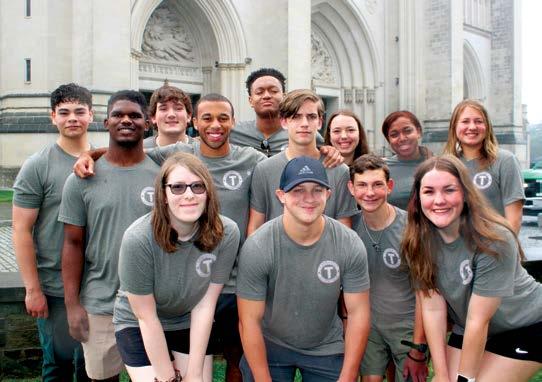


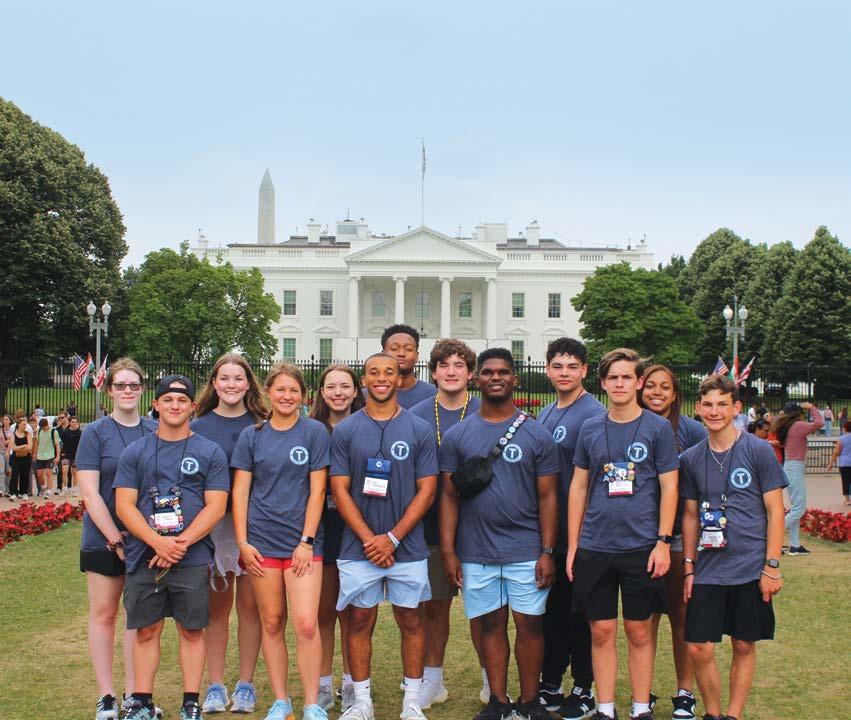
The Northcentral Electric Cooperative Annual Meeting of the Members will be held at 2 p.m. on Oct. 25, 2023, in the Northcentral Electric auditorium. Besides summarizing the work of the past year and highlighting future projects, the major business task at the Annual Meeting is the election of three members of the Board of Directors.
This year, board members are to be elected to serve a term of three years from District 1, District 4, and District 8 of our service area. More detailed descriptions of each district can be found in Section 4.02 of the bylaws, under the “Cooperative” section of Northcentral’s website at northcentralelectric.com.
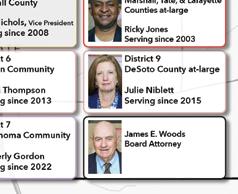
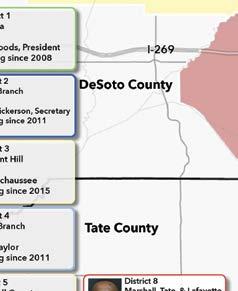
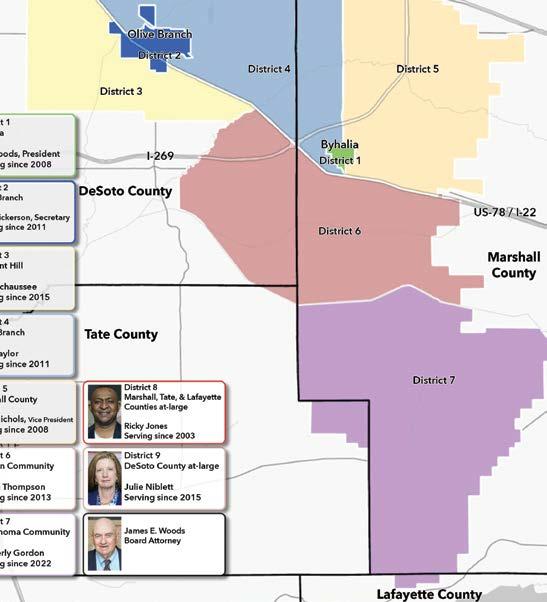
Current board members representing these districts are Pat Woods of District 1, Tony Taylor of District 4, and Ricky Jones of District 8.

Nominations to the Board of Directors, whether incumbent or new candidate, will be made by the membership. Any 25 or more members from the district from which a director is to be elected shall make a nomination by signing a nomination form with the nominee’s name and
district stated on the form. Nomination forms can be picked up from the receptionist’s desk in the Northcentral Electric Administrative Building. A list of the valid nominations will be posted at the Northcentral o ce.
The deadline for submission of nomination forms, as well as the schedule of meetings and deadlines for the Elections and Credentials Committee can be found under the “2023 Annual Meeting” link on the home page at northcentralelectric.com.
Members can vote either by proxy prior to the Annual Meeting or in person by ballot at the Annual Meeting. Proxies will be mailed to the membership and must be received in the Northcentral o ce no later than 2 p.m. on Oct. 23, 2023. The Elections and Credentials Committee will review the proxies for validation beginning at 2 p.m. on Oct. 23, 2023.
For more details on the Board of Directors elections, the Annual Meeting, bylaws, or the nomination process, visit the “2023 Annual Meeting” link on the home page at northcentralelectric.com.








Pearl River Valley Electric Power Association is pleased to once again announce that members will be receiving annual patronage capital returns in August.















Patronage capital, or capital credits, represents members’ investment in their not-for-profit electric cooperative. Each year, rates are set so that the Association has enough funding to operate throughout the year, and any year-end revenue above the cost of providing electric service is assigned to members as margins based on their share of electricity use. A portion of those margins is then returned to members each August. This year, Pearl River Valley Electric’s Board of Directors has authorized $3.5 million be returned to members.
“Capital credit returns are one of the advantages of being a member of a cooperative,” said Matthew Ware, CEO/general manager. “Our members share in the cost of doing business and benefit from any returns as well.”
While investor-owned utilities return a portion of any profits back to their investors, electric cooperatives assign margins to member-consumers as capital credits and pay them when the coop’s financial condition permits.
“Conservative management of the cooperative’s money by our Board of Directors has helped keep the Association financially sound,” Ware continued. “We have returned capital credits for 60 years, totaling nearly $71 million overall.”


Each qualifying active member will receive their return as credit applied to their power bill mailed in August. For inactive members who qualify, checks will be mailed in September.


In addition to annual patronage returns for members, Pearl River Valley Electric also o ers discounted capital credit returns to the estates of deceased members and to former members. A total of more than $18.3 million has been distributed overall through these programs, including more than $893,000 in 2022.

A group of 81 rising high school seniors from all over Mississippi traveled to Washington, D.C. in June to attend the 2023 NRECA Youth Tour.







The trip was the culmination of the students’ participation in the Electric Cooperatives of Mississippi’s youth leadership program.
The program instills leadership skills, inspires creative thinking, encourages community service, and introduces students to lawmakers that represent their communities.







During the March workshop in Jackson, the students had the opportunity to meet and hear from state legislators. During the trip to Washington, D.C., the students met and spoke with their U.S.
senators — Roger Wicker and Cindy Hyde-Smith — and two of their U.S. representatives, Mike Ezell and Michael Guest.






While in Washington, D.C., the students and adult chaperones visited historic sites, monuments, museums, explored Capitol Hill, and had an opportunity to learn about the impact electric cooperatives have on their communities.
The students were chosen by their local electric cooperative. The Cooperatives Youth Leaders program is fully funded — including the trip to D.C. — by the local electric co-ops as a commitment to molding future leaders for Mississippi so they can impact the state and local communities.




As a member of Pearl River Electric, you can take comfort in knowing that you are part of a large network of power companies that work together to provide you with affordable, reliable power. Here’s how it works:
Pearl River Electric and 10 other electric cooperatives across the state are partners with another electric cooperative known as Cooperative Energy.
Cooperative Energy operates the power plants that produce electricity, as well as the transmission lines that move electricity to you.
Because these 11 cooperatives are joined as one mutual source of power, your service is more affordable and reliable than it would be if each system operated alone.
Cooperative Energy is part of MISO, an even larger network that joins it with other power companies in the U.S. and Canada.

These companies work together to produce electricity for everyone from Mississippi to Manitoba at the lowest possible cost, and to make sure electricity is readily available.
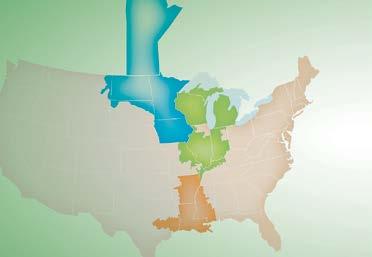
QI’m making an e ort to reduce my energy use, and I want my kids to start energy-saving habits as well. How can I encourage them to use less electricity at home?



Educating kids on energy use and costs can help engage them in your family’s goal to use less electricity. They can be electric conservation champions if you ask them to help. Here are some ways you can teach kids to use less electricity.
Show them how to read the electric bill. Focus on what you can control: kilowatt-hour use. If they are old enough, teach them how to do the math. You can calculate kWh use by multiplying wattage by hours used and dividing by 1,000. Multiply this by the kWh rate found on your electric bill to estimate how much you spend on power for each household appliance.
For example, if you have a space heater that uses 1,500 watts and is on for four hours a day for a month, it uses 180 kWh. With an average kWh rate of 13.7 cents in the United States, the space heater costs about $25 a month to operate. That same space heater costs about $74 a month if it is on for 12 hours per day. Your kWh rate may be lower or higher depending on where you live.



AWhen I was a kid, I dreamed of one day having a home where I could pay my own electric bill. Said no one ever. While it’s not the most fun way to spend money, people typically want to live in a home with electricity.





You can also leave the house during the hottest times of the day to go for a swim or play outside. Before you go, nudge up the thermostat a few degrees to avoid wasted energy cooling an empty house. Turn o fans when you leave a room.
The second-highest use of electricity is typically the electric water heater. Use a shower timer so bigger kids can monitor how long they are in the shower. Teach them to wash their clothes with cold water. If you have a gas water heater, look at the gas bill to find opportunities to save.

In the kitchen, keep the refrigerator door shut. Teach kids to take a quick peek and shut the door while they think about their snack options.
For household appliance wattage, look for the amount stamped on the bottom, back, or nameplate. If the nameplate does not include wattage, figure it out by multiplying the voltage by the amperage.


To teach children the impact of saving energy, have them help you conserve with the household’s biggest energy-consuming appliances: heating and cooling. Teach kids to dress appropriately for the seasons, even when they are indoors, which allows you to set the thermostat to balance comfort and savings.

Other ways to save include turning o the lights when you leave the room. The more we switch to LED lighting, the less savings associated. Yet even little changes can add up throughout the year. If your child needs a nightlight to sleep with, make sure it’s an LED bulb.
Powering down gaming stations and computers is another way to save. In the kitchen, keep the refrigerator door shut. Teach kids to take a quick peek and shut the door while they think about their snack options.
After teaching your kids about electric bills and showing them how to save electricity, make a game out of your family’s energy conservation e orts. Challenge the family to use less energy than last month or the same month last year. Use the savings to reward them with a treat or let the winner pick the game night activity or film for family movie night.
 Miranda Boutelle is the chief operating o cer at E ciency Services Group in Oregon, a cooperatively owned energy e ciency company.
Miranda Boutelle is the chief operating o cer at E ciency Services Group in Oregon, a cooperatively owned energy e ciency company.
A group of 81 rising high school seniors from all over Mississippi traveled to Washington, D.C. in June to attend the 2023 NRECA Youth Tour.







The trip was the culmination of the students’ participation in the Electric Cooperatives of Mississippi’s youth leadership program.
The program instills leadership skills, inspires creative thinking, encourages community service, and introduces students to lawmakers that represent their communities.








During the March workshop in Jackson, the students had the opportunity to meet and hear from state legislators. During the trip to Washington, D.C., the students met and spoke with their U.S.
senators — Roger Wicker and Cindy Hyde-Smith — and two of their U.S. representatives, Mike Ezell and Michael Guest.





While in Washington, D.C., the students and adult chaperones visited historic sites, monuments, museums, explored Capitol Hill, and had an opportunity to learn about the impact electric cooperatives have on their communities.
The students were chosen by their local electric cooperative. The Cooperatives Youth Leaders program is fully funded — including the trip to D.C. — by the local electric co-ops as a commitment to molding future leaders for Mississippi so they can impact the state and local communities.




JoAnne R. Bradley, PEPA retiree
INGREDIENTS
½ cup sugar to every 3 cups of water



½ cup freshly squeezed lemon juice
To every 3 cups of water
Mix and serve.
This recipe belongs to my daughter, Dr. Jerri Lamar Kantack.
Curtis (PEPA retiree) and Seretha Gregory
INGREDIENTS
1 head lettuce
½ cup chopped celery
2 tsp vinegar, sprinkled over mayo
1 small onion, chopped
Lavonia Lackey, Manager of Customer Accounts

INGREDIENTS
2 cups fresh broccoli florets
2 cups fresh cauliflower
1 medium cucumber, halved and thinly sliced
1 cup fresh sliced mushrooms
1 cup cherry tomatoes, halved
1⁄3 cup finely chopped red onion


½ cup fat-free Italian salad dressing
In a large bowl, combine broccoli, cauliflower, cucumber, mushrooms, tomatoes, and onion. Add dressing; toss to coat. Cover. Refrigerate for 8 hours or overnight.
Don (PEPA retiree) and Sandy Patterson
8 oz. grated sharp cheddar
1 cup frozen English peas
8 slices crispy fried bacon
1 pint Hellman’s mayo
Mix until well blended. Refrigerate. Serve with any fresh fruit.
INGREDIENTS


8 oz. cream cheese
red and white seedless grapes

8 oz. sour cream
1 cup pecans
1 cup sugar
brown sugar
Cream sugar and cream cheese together. Add sour cream, then add grapes and pecans. Sprinkle top with brown sugar.

Pontotoc Electric Power Association will be closed Monday, Sept. 4, 2023, in observance of Labor Day. To report outages or emergencies, please call 662-489-6711 (Pontotoc) or 662-983-2727 (Bruce). A Pontotoc Electric dispatcher is on duty 24 hours per day, seven days per week.





 AMANDA PARKER PR and Marketing Specialist
AMANDA PARKER PR and Marketing Specialist

 LORRI FREEMAN, APR Manager of PR and Marketing SAMUEL GOFF PR and Marketing Coordinator
LORRI FREEMAN, APR Manager of PR and Marketing SAMUEL GOFF PR and Marketing Coordinator




I’m sure many of you have children or grandchildren eager to begin the new school year. Thoughts likely include the anticipation of meeting new teachers, seeing old friends, making new friends, and even buying new school supplies. For some of us, it may be the anxiety of sending a child o to college or to the final year of high school.

Local teachers and administrators have been working for weeks preparing for the big day. These special individuals play a critical role in the development of our children and grandchildren and need the community’s support. We all play a role in our local schools’ success. It’s more than slowing down in the school zones; it’s about being involved in the schools and communities we love.
Singing River Electric understands this and is committed to the schools in our communities. We contribute to local chambers of commerce scholarship programs for those entering college,
sponsor a youth leadership program for high school juniors, and participate in the Pathways2Possibilities Career Fair to help local middle school students explore job fields and potential careers. Our engineers and linemen visit elementary classrooms across the service territory demonstrating the importance of safety.

The real impact is interaction. Whether our employees are coaching a sports team, working with the school PTA, or purchasing items during the holidays to support a classroom, Singing River Electric wants our local students and teachers to know we care.
Education is vital to the economic growth and well-being of the communities where we live and work. I ask you to join us in supporting our schools and teachers through volunteering or helping in some way. Our students deserve nothing less than the best education we can provide them.
 Gabe Robbins Energy Services Representative robbins@singingriver.com
Gabe Robbins Energy Services Representative robbins@singingriver.com

It’s August, and the heat of summer is here. Not only is the heat uncomfortable but it also causes our air conditioners to work harder. With the A/C being the largest contributor to your electric bill during the summer months, operating e ciency plays a large role in keeping your electric bill down. These three things can help you reach maximum HVAC operation e ciency:
• Service your unit – If you have not recently had a licensed HVAC employee service your unit, it’s time to do this. Cleaning coils and checking freon levels will assure that your unit is working to the best of its ability. For instance, if the freon levels are a ½ pound low, your unit could operate 30% more or longer to do the same job.
• Change your filter – Replacing air filters keeps our HVAC system working properly and keeps energy bills lower. Neglecting to do so can increase your energy use and potentially contribute to other maintenance issues later.
• Keep your outside condensing unit clear – Be sure your outside unit is free of vines and any type of debris that could obstruct air flow to the unit. The condensing unit relies on proper air flow to ensure maximum e ciency of your HVAC system. Any wood or tin structures designed to keep the unit out of the weather may also be obstructing air flow.
Visit singingriver.com/ways-to-save for more energy-saving tips.




• Energized the Cumbest Blu substation in Jackson County.
• Continued construction of a SCADA system connecting all SRE substations and o ces to provide real-time data and minimize outage response times and give engineers greater control of the electrical distribution system.
• Retired more than $2 million in capital credits to SRE members for the year 1996; Cooperative Energy retired $1.5 million in capital credits to SRE members for the year 1992 and partial returns for the years 2007, 2008, and 2009.
• Assisted other Mississippi electric co-ops following storms.
• Commissioned 39 solar home installations.
• Awarded more than $15,000 in NHN Community Grants to local nonprofits.

• Re-cleared 1,022 right-of-way miles to ensure reliable electric service to members.
• Awarded 222 heat pump rebates.

• Certified 76 Comfort Advantage homes.
• Awarded scholarships to local students through chamber of commerce programs.
• Hosted Cooperative University and sent three local high school juniors for the 2022 ECM Youth Leadership Workshop and Youth Tour of Washington, D.C.
Singing River Electric (SRE) held its 2023 Annual Membership Meeting on Thursday, June 29.

During the meeting, General Manager and CEO Brian Hughey reviewed the highlights from the previous year and shared some accomplishments and goals for 2023.
One of the most important accomplishments from 2022 was successfully renewing our Electric Cooperatives of Mississippi Safety Certification with a score of 95.9%. While SRE employees have always kept safety as a primary focus, participating in the audit requires employees and management to take a deeper dive into work practices and work areas.
SRE retired more than $2 million to members in capital credits, representing the year 1996. Cooperative Energy, SRE’s generation partner, retired $1.5 million in capital credits to SRE members for the year 1992 and partial returns for the years 2007, 2008, and 2009.
From a reliability standpoint, the co-op energized the new Cumbest Blu substation in Jackson County, upgraded numerous copper lines to more durable aluminum wiring in George and Greene counties, and converted single-phase to three-phase line across the entire service territory.
Fiber internet construction expanded. SRE now owns and operates nearly 2,000 miles of fiber that is leased to our fiber subsidiary, Singing River Connect (SRC). To date, SRC has more than 4,000 high-speed internet subscribers located within all three geographical SRE districts. It was reported that the a liate is seeing an average rate of 50% for those that take the fiber service, and subscriber
feedback is extremely positive with many stating the service exceeds their expectations in quality product, service, and pricing.
Fiber construction crews are building more than 30 miles of fiber each week. SRC now has fiber internet service open in 10 of SRE’s substation areas covering seven Mississippi counties and one Alabama county served by the electric co-op. As crews work to complete Phase 2 of fiber construction and enter Phase 3, another 1,800 miles of fiber construction will begin and pass more than 16,000 potential fiber internet subscribers in Greene, Wayne, George, and Jackson counties.
Meeting attendees participated in board elections online, by SmartHub mobile app, and mailed proxies. Three Singing River Electric members were re-elected at the meeting to serve three-year terms on the cooperative’s board of directors.
• James (Robert) Steele, District 1
• Roy C. Grafe, District 2
• Kristal K. Sisson, District 3
For a full list of board members, visit singingriver.com/my-coop/#board.
Singing River Electric members Linda Eckford, Philip Busby, Obie Wells and Richard Fleming served on the 2023 Credential and Election Committee. The committee reviews and approves board candidates, oversees elections, and sees first-hand the e orts made to be transparent when conducting business of the electric cooperative.
To view the 2022 SRE Annual Report, visit singingriver.com/my-coop.
• Helped clean up the Pascagoula River by participating in Renew Our Rivers, clear invasive species of plants at Moss Point’s Sawmill Landing, painted bleachers and scoreboard at the Leakesville tennis courts and beautified boat launch areas at George County’s Wilkerson Ferry West and Jackson County’s Bennett Bayou Preserve.
• MSRs answered more than 122,000 calls in 2022.
• Completed fiber construction of a total of more than 2,100 miles of fiber lines and moved into Phase 3 of construction.
• Provided high-speed internet to nearly 2,000 subscribers in 10 of SRE’s substation areas covering seven Mississippi counties and one Alabama county.


$500 winner: Jackie Taylor of Ocean Springs.
$250 winners: Melissa Clark of Leakesville, Marshall Havard of Lucedale, Harry McDonald of Richton, Jesse Pettus of Escatawpa, Marcia Pierce of Lucedale, and Michelle Sabree of Ocean Springs.










A group of 81 rising high school seniors from all over Mississippi traveled to Washington, D.C. in June to attend the 2023 NRECA Youth Tour.





The trip was the culmination of the students' participation in the Electric Cooperatives of Mississippi’s youth leadership program.


Kameryn Bardwell of East Central High School, Kevin McLain of Wayne County High School, and Daniel Pickens of Resurrection High School were Singing River Electric’s youth representatives.

The program instills leadership skills, inspires creative thinking, encourages community service, and introduces students to lawmakers that represent their communities.


During the March workshop in Jackson, the students had the opportunity to meet and hear from state legislators. During the trip to Washington, D.C., the students met and spoke with their U.S. senators — Roger Wicker and Cindy Hyde-Smith — and two of their U.S. representatives, Mike Ezell and Michael Guest.
While in Washington, D.C., the students and adult chaperones visited historic sites, monuments, museums, explored Capitol Hill, and had an opportunity to learn about the impact electric cooperatives have on their communities.
The Cooperatives Youth Leaders program is fully funded — including the trip to D.C. — by the local electric co-ops as a commitment to molding future leaders for Mississippi so they can impact the state and local communities.




STEP 1: Make-ready engineering Examine. Design.
Vancleave substation
STEP 2: Make-ready construction
Planning the most efficient approach to fiber deployment.
Lucedale North, Leakesville, and Joe Batt substations
STEP 3: Construction
Building a network from the ground up.
Big Point, Frank Snell, McLain, and Sand Hill substations
STEP 4: Splicing
Connecting the dots.
Kittrell and State Line substations
STEP 5: Service drop & drop splicing
The last outdoor step. Almost there…
Sawmill substation and any previously opened fi ber areas
STEP 6: Installation
The speed of light, right to your home.
Sawmill substation and any previously opened fi ber areas

SR Connect is delivering lightning-fast, fiber internet. New fiber areas are announced by electric substation and feeder. You can search open fiber areas and your address for service at singingriverconnect.com/signup. To find out which SRE substation and feeder serves your home, text SRE MSR during business hours at 228-591-9166. Scan here!
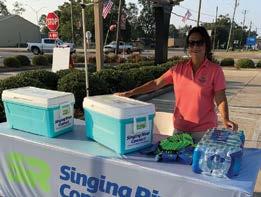



SRC sponsored the water table for participants at a recent City of Lucedale Park 5K and Fun Run event. The event was held to raise money to rebuild the Lucedale Municipal Park facilities and playground. The playground was installed in 1995 and the redesign includes purchasing new playground equipment and building a retaining wall to fix an erosion issue.
singingriverconnect.com




















If it’s connected, it’s protected. Whole home network security for all your devices.

With the daily cost of living increases that we’re seeing across the board, it’s only fair that members wonder what impacts their electric bill each month. August is one of those months where electric bills increase because of the unbearable Mississippi heat that causes members to consume more electricity to cool their homes and businesses.
I thought it would be a good idea to help explain some factors that impact electricity prices (and energy bills) in this month’s issue. A few key elements a ect electricity prices and rates. Your monthly electric bill has three primary parts: a service charge, an energy consumption (kWh charge), and a Power Cost Adjustment (PCA).
The first is a fixed monthly service charge of $1 per day, which covers the costs of providing electricity to your home. The service charge covers the equipment, materials, labor, and operating expenses necessary to serve each meter in Southern Pine’s service territory, regardless of the energy used. It also covers expenses related to storm recovery. We must maintain the local system, including power lines, substations, and other necessary equipment, to ensure the reliable service you expect and deserve.
Another component of your monthly bill is the kWh charge, which covers how much energy you consume over a month. The price per kilowatt rarely changes, and when it does it’s only after notifying members before a change. As you know, your energy consumption varies monthly, especially during extreme temperatures. The single biggest electricity use is heating and cooling, so when temperatures soar or dip, your unit runs longer, increasing your home energy use. Regardless, energy consumption is an area that you have some control over, and you can lower your monthly bill by actively reducing energy use. Your thermostat is a great place to start, so keeping it set as high as possible in the summer will save you money.
The last component of your bill is the Power Cost Adjustment (PCA), which is the same amount for all residential co-op members. The PCA




changes on occasion, but has minimal impact on your electric bill. Each year, Southern Pine estimates what the average wholesale power cost from Cooperative Energy will be for the year. The PCA is used to “true up” the di erence between the estimate and the actual cost. It recently increased because of higher fuel prices, material expenses, and energy policies from the federal government, making it more expensive for Cooperative Energy to produce electricity. When fuel costs and material expenses are lower the PCA is also adjusted down, taking a few dollars o your bill.
You see, of the three components of your bill — the service charge, the kWh charge, and the PCA — the one that has the most impact on your bill is the kWh charge, which measures monthly usage. The bottom line is that consumption substantially impacts your electric bill each month, so take measures to reduce your use as much as possible while remaining comfortable.

Just as inflation has impacted everything from the price of gasoline to the price of eggs, costs for the fuels and equipment required to produce electricity have also risen. While we can’t control the weather or the rising costs, Southern Pine is doing everything possible to keep internal costs down. We’re here to help you, too. I encourage you to visit www.southernpine.coop for ideas that can help you reduce your energy use at home and your costs.

 by Chris K. Rhodes
President/CEO Southern Pine Electric
by Chris K. Rhodes
President/CEO Southern Pine Electric


Southern Pine is doing everything possible to keep internal costs down. We’re here to help you, too. I encourage you to visit www.southernpine.coop for ideas that can help you reduce your energy use at home and your costs.
A group of 81 rising high school seniors from all over Mississippi traveled to Washington, D.C. in June to attend the 2023 NRECA Youth Tour.









The trip was the culmination of the students’ participation in the Electric Cooperatives of Mississippi’s youth leadership program.
The program instills leadership skills, inspires creative thinking, encourages community service, and introduces students to lawmakers that represent their communities.






During the March workshop in Jackson, the students had the opportunity to meet and hear from state legislators. During the trip to Washington, D.C., the students met and spoke with their U.S.
senators — Roger Wicker and Cindy Hyde-Smith — and two of their U.S. representatives, Mike Ezell and Michael Guest.






While in Washington, D.C., the students and adult chaperones visited historic sites, monuments, museums, explored Capitol Hill, and had an opportunity to learn about the impact electric cooperatives have on their communities.
The students were chosen by their local electric cooperative. The Cooperatives Youth Leaders program is fully funded — including the trip to D.C. — by the local electric co-ops as a commitment to molding future leaders for Mississippi so they can impact the state and local communities.




 by Taylor Parker Avera
by Taylor Parker Avera
On Friday, June 16, 2023, storms ripped through Mississippi, causing many power outages and severe damage. My husband, Cole, works with Southern Pine Electric. We always know that he will likely be away from home working when the storms come. This storm hit our family hard. We had a huge oak tree uprooted on our house and multiple trees on fences on our cattle farm, and it blew our corn crop entirely over.

Soon after it hit, and after making sure everything with our house was okay and the cleanup could wait until later, Cole headed out to work to help restore power! We also had no power or water due to the tree breaking water lines. As a wife of a line worker, this can become very stressful. You now have multiple roles you must play and many things that must be tended to and done by you. Not only are the everyday mom and household jobs your responsibility, but I was also having to figure out how we would get this big tree o our house, get the farm tended to, and try and salvage the crops that had been damaged by the storm. Cole was
working with the entire Southern Pine team on the outages caused by the storm, and he needed his full attention to return safely to us at home.


I have always said Stringer was one of the best places to live, and we couldn’t have better neighbors! This storm proved that to me again. When Cole left Friday morning headed to restore power, his last words were, “Just leave the mess, and when I get done working, we will worry about getting everything cleaned up.” Neighbors, family, and friends saw a need to get things done and wouldn’t have it any other way than to start bright and early Saturday morning cleaning up and picking corn. By lunch on Saturday, we had the big tree o the house and the corn harvested. Granted, a lot of yard work still needed to be done and trees to be taken o fences, but all of that could happen later as it wasn’t pressing or required to be done immediately.
Being the wife of a line worker isn’t always easy. You never know when they will be called to work, or when they will be home. It also gets very frustrating with the multiple comments of people complaining about no power. I have never once complained of having no electricity. I make do; because I know that my husband and many men are working in thunderstorms, cutting trees o lines, working in hot temperatures, and other harsh conditions to help others. I assure you these men want to get power to everyone as quickly as possible; they don’t want to leave anyone in the dark. Just remember that these men have their own families and may be going to work with a mess at home to clean up later. Still, they are doing all they can to help restore power to the people.




The Board of Directors has voted to return $1,459,917.76 to Members. Active Members who had accounts in 2022 will receive a credit on their August bill. The Current Service Detail example on the right shows how the credit will appear on the August bills. Members with inactive accounts will be mailed a check on August 11.
Southwest Electric is a Member-owned electric cooperative. Unlike an investor-owned utility, we do not operate to make a profit. By paying electric bills, Members cover operating expenses, and the










Our o ce will be closed
Monday, September 4, in observance of




remaining funds are invested in the utility plant. The Members’ investment is called a patronage capital credit. It is allocated to our Members’ accounts based on how much electricity they used that year. Members who use more electricity will have a bigger investment. Likewise, Members who use less will have a smaller investment.
Since 1960, Southwest Electric has returned over $31 million in patronage capital to our Members.




Dispatchers will remain on duty and crews will be on call throughout the holiday weekend. If you experience an outage, report it on the SmartHub app or call 800-287-8564.

A group of 81 rising high school seniors from all over Mississippi traveled to Washington, D.C. in June to attend the 2023 NRECA Youth Tour.







The trip was the culmination of the students’ participation in the Electric Cooperatives of Mississippi’s youth leadership program.
The program instills leadership skills, inspires creative thinking, encourages community service, and introduces students to lawmakers that represent their communities.








During the March workshop in Jackson, the students had the opportunity to meet and hear from state legislators. During the trip to Washington, D.C., the students met and spoke with their U.S.
senators — Roger Wicker and Cindy Hyde-Smith — and two of their U.S. representatives, Mike Ezell and Michael Guest.





While in Washington, D.C., the students and adult chaperones visited historic sites, monuments, museums, explored Capitol Hill, and had an opportunity to learn about the impact electric cooperatives have on their communities.
The students were chosen by their local electric cooperative. The Cooperatives Youth Leaders program is fully funded — including the trip to D.C. — by the local electric co-ops as a commitment to molding future leaders for Mississippi so they can impact the state and local communities.







Here are five relatively inexpensive ways you can reduce your power consumption during the summer months. Every little bit helps save energy.
1
2
CHANGE YOUR AIR FILTERS regularly. We recommend at least once a month. Your unit will not have to work as hard.
Southwest Electric employees joined forces with Cooperative Energy representatives to host the first Summer Engagement program for the Energy Academy at Port Gibson High School on June 6. This all-day event was well received by students rotating through seven different stations. Students learned safety around electricity, how to frame a pole, how drones are used in our industry, the tools a lineman uses, where power comes from, how a meter works and operated a generator system on a bicycle that powers a light bulb.
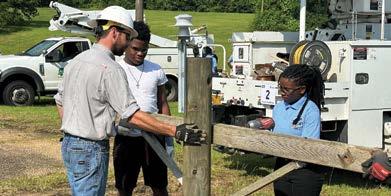
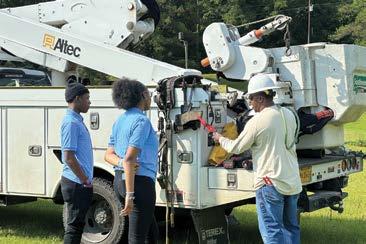

The purpose of the Energy Academy is to introduce young people to the possibilities that exist in the energy industry when they study science, technology, engineering and mathematics.
3
KEEP YOUR THERMOSTAT SET as high as possible to remain comfortable. We recommend 78 degrees.
4
USE FANS WHEN POSSIBLE and run them only when you are in the room. Fans cool people, not the air.

5
SEAL ANY CRACKS or air leaks with caulking to keep the hot air out of your home.





I was recently asked about what exactly impacts electricity prices. We talked about how the daily cost of living seems to have increased across the board.
Just as inflation has impacted everything from the price of gasoline to the price of eggs, costs for the fuels required to produce electricity have also risen. This is a timely topic, so I wanted to help explain some of the factors that impact electricity prices (and energy bills) in this month’s issue of Today in Mississippi.
While there is no short answer, there are a few key elements that impact electricity prices and rates. Some of these factors Twin County can manage, some of them you can impact, and other factors are beyond our control. So, let me break it down.
There are three primary parts to your monthly electric bill: a service charge, an energy consumption/kWh charge, and a Power Cost Adjustment or PCA. To understand your total energy costs and what impacts your bill, lets unpack one piece at a time.

The first is a fixed monthly service charge, which covers the costs associated with providing electricity to your home. This includes equipment, materials, labor, and operating costs necessary to serve each meter in Twin County’s service territory, regardless of the amount of energy used. In order to ensure the reliable service you expect and deserve, we must maintain the local system, including power lines, substations, and other necessary equipment. Like many other businesses, we’ve experienced supply chain issues and steep cost increases for some of our basic equipment. For example, the cost for a distribution transformer (which looks like a long metal can at the top of a power pole) went up to $2,400 this year, and wait times to receive this essential equipment are up to 20 weeks. Because we are a not-for-profit cooperative, some of these expenses must be passed on to our members. I should note that the service charge is the same for everyone and the costs are shared equally across the membership.
Another component of your monthly bill is the kWh charge, which covers how much energy you consume. You’ve likely noticed the amount of energy you use can vary from month to month and is typically impacted by extreme temperatures. When temperatures soar or dip, your cooling and heating equipment run longer, which increases your home energy use. Regardless, energy consumption is an area that you have some control over, and you can lower your monthly bill by actively reducing energy use. Your thermostat is a great place to start, so be sure to keep it close to 78 degrees during summer months.
The last component of your bill is the PCA, which is the same amount for all co-op members. The PCA recently increased because of higher fuel prices, which means the power that Twin County purchases from our wholesale provider is more expensive. The PCA covers fuel cost fluctuations without having to continually restructure electricity rates.

I hope this information sheds light on some of the factors that impact electricity prices. While we can’t control the weather or the rising costs of fuels, please know Twin County is doing everything possible to keep internal costs down.











1) Fixed monthly service charge



2) Energy consumption/kWh charge


3) Power Cost Adjustment

A group of 81 rising high school seniors from all over Mississippi traveled to Washington, D.C. in June to attend the 2023 NRECA Youth Tour.







The trip was the culmination of the students’ participation in the Electric Cooperatives of Mississippi’s youth leadership program.
The program instills leadership skills, inspires creative thinking, encourages community service, and introduces students to lawmakers that represent their communities.







During the March workshop in Jackson, the students had the opportunity to meet and hear from state legislators. During the trip to Washington, D.C., the students met and spoke with their U.S.
senators — Roger Wicker and Cindy Hyde-Smith — and two of their U.S. representatives, Mike Ezell and Michael Guest.






While in Washington, D.C., the students and adult chaperones visited historic sites, monuments, museums, explored Capitol Hill, and had an opportunity to learn about the impact electric cooperatives have on their communities.
The students were chosen by their local electric cooperative. The Cooperatives Youth Leaders program is fully funded — including the trip to D.C. — by the local electric co-ops as a commitment to molding future leaders for Mississippi so they can impact the state and local communities.




QI’m making an e ort to reduce my energy use, and I want my kids to start energy-saving habits as well. How can I encourage them to use less electricity at home?
Educating kids on energy use and costs can help engage them in your family’s goal to use less electricity. They can be electric conservation champions if you ask them to help. Here are some ways you can teach kids to use less electricity.
Show them how to read the electric bill. Focus on what you can control: kilowatt-hour use. If they are old enough, teach them how to do the math. You can calculate kWh use by multiplying wattage by hours used and dividing by 1,000. Multiply this by the kWh rate found on your electric bill to estimate how much you spend on power for each household appliance.
For example, if you have a space heater that uses 1,500 watts and is on for four hours a day for a month, it uses 180 kWh. With an average kWh rate of 13.7 cents in the United States, the space heater costs about $25 a month to operate. That same space heater costs about $74 a month if it is on for 12 hours per day. Your kWh rate may be lower or higher depending on where you live.
AWhen I was a kid, I dreamed of one day having a home where I could pay my own electric bill. Said no one ever. While it’s not the most fun way to spend money, people typically want to live in a home with electricity.
You can also leave the house during the hottest times of the day to go for a swim or play outside. Before you go, nudge up the thermostat a few degrees to avoid wasted energy cooling an empty house. Turn o fans when you leave a room.
The second-highest use of electricity is typically the electric water heater. Use a shower timer so bigger kids can monitor how long they are in the shower. Teach them to wash their clothes with cold water. If you have a gas water heater, look at the gas bill to find opportunities to save.
In the kitchen, keep the refrigerator door shut. Teach kids to take a quick peek and shut the door while they think about their snack options.
For household appliance wattage, look for the amount stamped on the bottom, back, or nameplate. If the nameplate does not include wattage, figure it out by multiplying the voltage by the amperage.
To teach children the impact of saving energy, have them help you conserve with the household’s biggest energy-consuming appliances: heating and cooling. Teach kids to dress appropriately for the seasons, even when they are indoors, which allows you to set the thermostat to balance comfort and savings.
• JULY 20, 2023
Other ways to save include turning o the lights when you leave the room. The more we switch to LED lighting, the less savings associated. Yet even little changes can add up throughout the year. If your child needs a nightlight to sleep with, make sure it’s an LED bulb.
Powering down gaming stations and computers is another way to save. In the kitchen, keep the refrigerator door shut. Teach kids to take a quick peek and shut the door while they think about their snack options.
After teaching your kids about electric bills and showing them how to save electricity, make a game out of your family’s energy conservation e orts. Challenge the family to use less energy than last month or the same month last year. Use the savings to reward them with a treat or let the winner pick the game night activity or film for family movie night.
Miranda Boutelle is the chief operating o cer at E ciency Services Group in Oregon, a cooperatively owned energy e ciency company.
• “Record Date” for Twin County’s 2023 Annual Meeting.
• JULY 21, 2023
• Petitions to run for director are available at the Hollandale o ce.

• AUG. 11, 2023
• Petitions to run for director must be filed at the Hollandale o ce by 5 p.m.
• ON OR BEFORE SEPT. 1, 2023
Annual meeting notices, annual reports, and proxies are mailed to all members in good standing as of the Record Date.

• SEPT. 20, 2023 • All proxies must be received by 5 p.m. at any of Twin County’s o ces.

• SEPT. 26, 2023
• Twin County
Annual Meeting in Hollandale beginning at 1:30 p.m.



















The large American flag that once flew above downtown Yazoo City for years has been restored thanks to the leadership of the Ray Davis of VFW Post 4302.


Post Commander Hugh Long and Yazoo City businessman Alan Ramsay recently contacted Yazoo Valley Electric Association seeking assistance restoring the flagpole at the bottom of Broadway Hill in front of Yazoo Donuts. The pole needed a new rope and hardware to raise the flag, and at over 60 feet tall, making the repairs was proving to be a challenge.
Yazoo Valley’s largest bucket truck was up to the task. Yazoo Valley employees also helped make repairs to lights that will shine on the flag at night and clean up the lot. Ramsay purchased new bulbs, had the lot mowed, and had some electrical repairs made to the wiring of the lighting system.

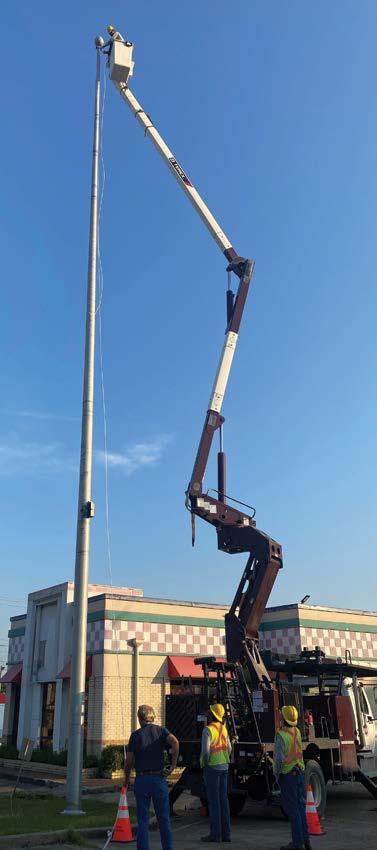
A scheduled public ceremony to raise the flag on Flag Day got rained out, but the flag was later raised to the delight of many local residents who appreciate the patriotic display.
Yazoo Valley Electric Power Association was proud to be able to contribute to this community project.
A group of 81 rising high school seniors from all over Mississippi traveled to Washington, D.C. in June to attend the 2023 NRECA Youth Tour.







The trip was the culmination of the students’ participation in the Electric Cooperatives of Mississippi’s youth leadership program.
The program instills leadership skills, inspires creative thinking, encourages community service, and introduces students to lawmakers that represent their communities.







During the March workshop in Jackson, the students had the opportunity to meet and hear from state legislators. During the trip to Washington, D.C., the students met and spoke with their U.S.
senators — Roger Wicker and Cindy Hyde-Smith — and two of their U.S. representatives, Mike Ezell and Michael Guest.






While in Washington, D.C., the students and adult chaperones visited historic sites, monuments, museums, explored Capitol Hill, and had an opportunity to learn about the impact electric cooperatives have on their communities.
The students were chosen by their local electric cooperative. The Cooperatives Youth Leaders program is fully funded — including the trip to D.C. — by the local electric co-ops as a commitment to molding future leaders for Mississippi so they can impact the state and local communities.



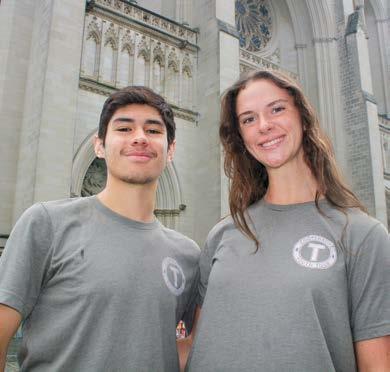


The sounds of laughter filled the building on July 5 as Yazoo Valley Electric Power Association said goodbye to Eddie Earl Douglas with a retirement celebration on his birthday.
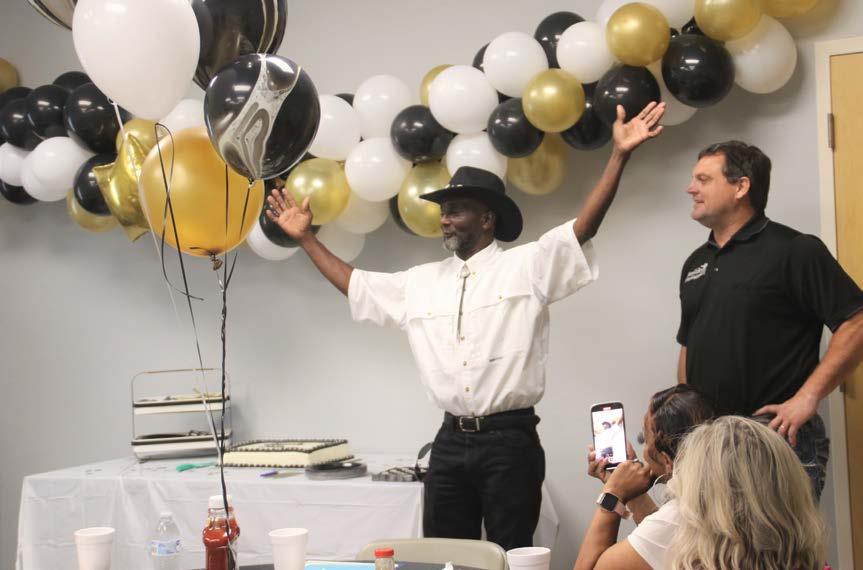
Laughter was to be expected as Douglas has inspired plenty of it over the last 27 years during his career at Yazoo Valley. Douglas has always been known for his sense of humor.

“We’re going to miss Eddie dearly,” said General Manager Michael Neely. “He brought laughter, camaraderie, and a whole lot of chaos to the o ce. We’ll remember his hilarious outbursts during safety meetings, his fast talking, and how he could e ortlessly turn a boring Monday into an unforgettable day. Thank you, Eddie for making our workplace a lot more fun and reminding us all not to take ourselves too seriously.”
Douglas worked in operations from 1990 to 2007 starting as an apprentice lineman before working his way up to lineman. He transferred to Member Services in 2007 and served as a meter apparatus shop assistant for a year before joining the Information Technology department as a metering apparatus assistant.


“You’ve left a unique mark on this company,” Neely said. “You are truly unforgettable.”







Douglas said it wasn’t easy for him to say goodbye to Yazoo Valley, but he plans to stay in touch.

“I’m going to miss every one of y’all,” Douglas said. “We’re one family here. I love all of y’all.”




During his retirement party coworkers shared funny stories about Douglas and his antics, and also remembered him as a true friend who cared about others.
“Eddie has always been there for me,” Paul Buxton said. “I remember when my dad died, we came home from making arrangements, and Eddie had been there and cut the grass for me. He is always doing something for someone else.”

This past June, a group of 81 high school juniors from all over the state had the opportunity to visit Washington, D.C. for a week representing Mississippi at the 2023 NRECA Youth Tour.
If you read the first quote at the bottom of this column, you can see the kind of impact a trip like this can have on our young people.
Emma Thomas is obviously somebody who has plans in the future to become a leader. Whether that turns out to be as a public servant in Washington, D.C., a state or local elected o cial in Mississippi, or as a local business owner or volunteer back home, we all need the Emma Thomases of the world to step up and give their time and talents to the betterment of our communities.
That’s what the Electric Cooperatives of Mississippi’s youth leadership program is all about, and it’s a responsibility that electric co-ops take seriously.
That’s why local co-ops fully fund the program, which instills leadership skills, inspires creative thinking, encourages community service, and introduces students to lawmakers that represent their communities.
Maybe a youth leadership program student saw the Lincoln Memorial for the first time on this trip. Maybe a student had a lifechanging conversation with Mississippi’s U.S. Sen. Cindy Hyde-Smith.
We want the young people of our communities to learn, grow and experience, so they can contribute to the future of our state.
The trip to D.C. and the future of the state should also reminds us about the importance of our members voting.
A primary election for statewide o cials is being held this month with the general election set for Nov. 7.
One of the ways all of us can contribute to the future of Mississippi is by voting.
To that end, we have created an initiative and website that gives you all the information you need to make an informed vote.
Co-ops Vote MS is the initiative. The message is this:
You have the POWER to Register. Be Informed. Vote.
When our youth leadership students visited the many memorials and museums in our nation’s capital city, they learned about the sacrifices those who came before us made so we can exercise our right to vote.
Don’t let those sacrifices go to waste.
by Michael Callahan Executive Vice President/CEO Electric Cooperatives of Mississippi
“This was a dream, and I don’t say that metaphorically. Washington, D.C. is where I plan to work. It’s where I plan to create a better nation through politics. To be able to see this place with other Mississippi leaders is a privilege. I’m so incredibly grateful for Southern Pine Electric and Electric Cooperatives of Mississippi for this life changing experience.”
— Emma Thomas 2023 Youth Tour student Southern Pine Electric“The opportunity to attend the 2023 NRECA Youth Tour in Washington, D.C., was truly an unforgettable experience. Visiting the monuments, memorials, and museums deepened my appreciation for my freedoms, for those who gave their lives for my freedoms, and my sense of responsibility to help lead my fellow American citizens.”
— Kameryn Bardwell 2023 Youth Tour student Singing River ElectricMississippi, land of poverty, A place where many struggle to be, Despite your beauty and southern charm, Your people face challenges that do harm.
From the Delta to the coast, Your poverty rate is among the most, With high unemployment and lack of education, Your people face a daily frustration.
But even in the midst of struggle and strife, Your people hold on to hope and life, With strength and resilience in their hearts, They work to make a better start.
So here’s to Mississippi, a state of grace, Where even in poverty, there’s a still a place, For hope and love and community, That bind your people together in unity.
by Mason Walker, a resident of Natchez,and a member of Southwest Electric.

















